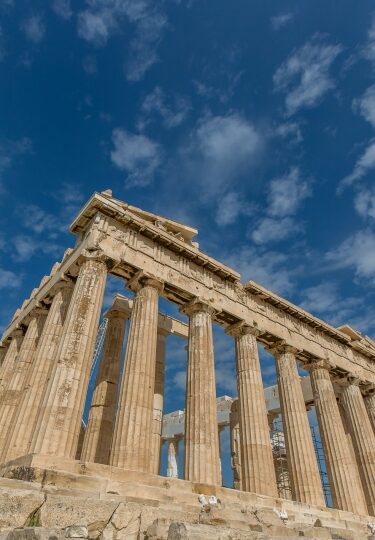You can hardly turn a corner in Europe without stumbling upon a majestic monument—indeed, the continent is home to an embarrassment of riches when it comes to incredible landmarks. Whether it’s the Eiffel Tower in Paris, the Colosseum in Rome, or the Leaning Tower of Pisa, many of the most famous landmarks in Europe require no introduction.
Of course, with so many famous monuments in Europe, you certainly won’t lack choice on your next big European adventure—the only hard part will be prioritizing which one to see first. From mysterious 5,000-year-old monoliths to a whimsical work-in-progress basilica, each of these sites comes loaded with spectacular architecture, artwork, and history. Just bear in mind that these historical treasures are popular and to visit most of them, you’ll need to plan well ahead.
Here, we’ve rounded up 27 of the most famous landmarks in Europe, each well deserving of a spot on your bucket list.
Eiffel Tower, Paris, France

Eiffel Tower in Paris, France
A beacon over the City of Lights, the 1,063-foot-high Eiffel Tower—soaring over the southwest side of the city, from its base in the 7th arrondissement—has become a symbol synonymous not just with Paris, but France as a whole.
Conceptualized by French engineer Gustave Eiffel as a temporary yet revolutionary structure for the 1889 World’s Fair, it’s hard to imagine that the open-lattice, wrought-iron tower was destined to be demolished after just 20 years.
Indeed, the tower’s unusual aesthetic was a matter of great public controversy, but, ultimately, it was spared from demolition, thanks largely to its utilitarian potential as a telecommunications tower. Today, the city’s signature spire is a firm fixture on the Parisian cityscape, marking one of the most famous landmarks in Europe—and the world.
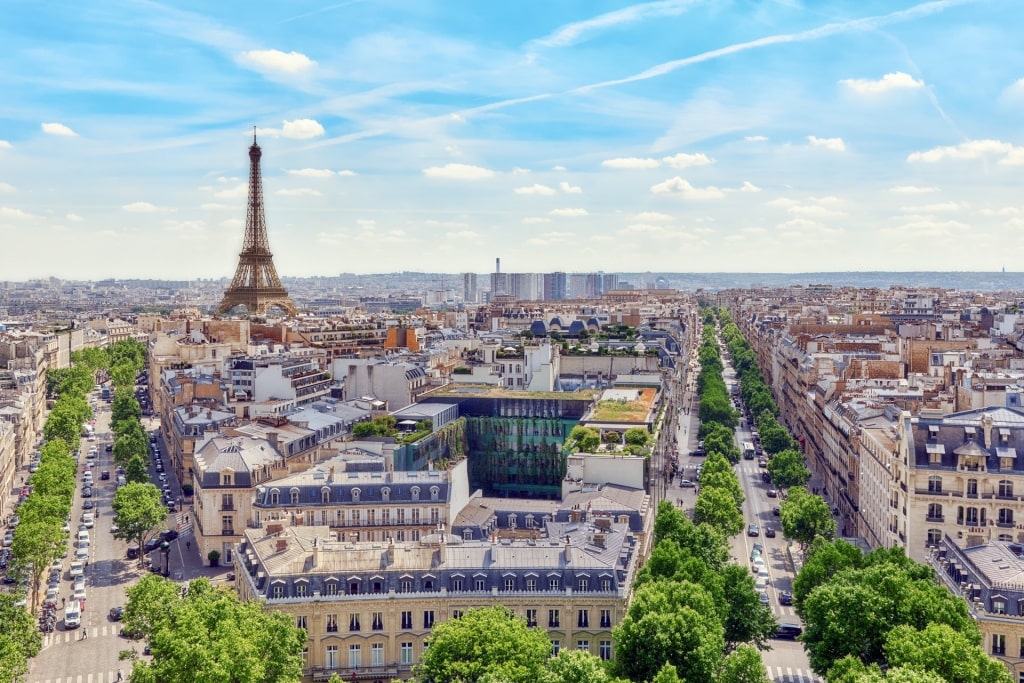
Paris, France
Any visit to Paris is defined by the backdrop of the colossal tower’s thin frame, looming in the distance (bonus: it provides a reliable orientation point for visitors). And, of course, the city views from atop are unsurpassed—a combination of elevators and stairs will whisk you up to three tower levels and viewing platforms, with varying attractions like a Champagne bar, Michelin-starred restaurant, and transparent glass floor.
The tower is arguably even more breathtaking at night, when it sparkles in the intermittent illumination of thousands of twinkling lights. France is known for its Eiffel Tower views, so soak up some of the most dramatic from the Palais de Chaillot esplanade, just across the Seine River.
Colosseum, Rome, Italy
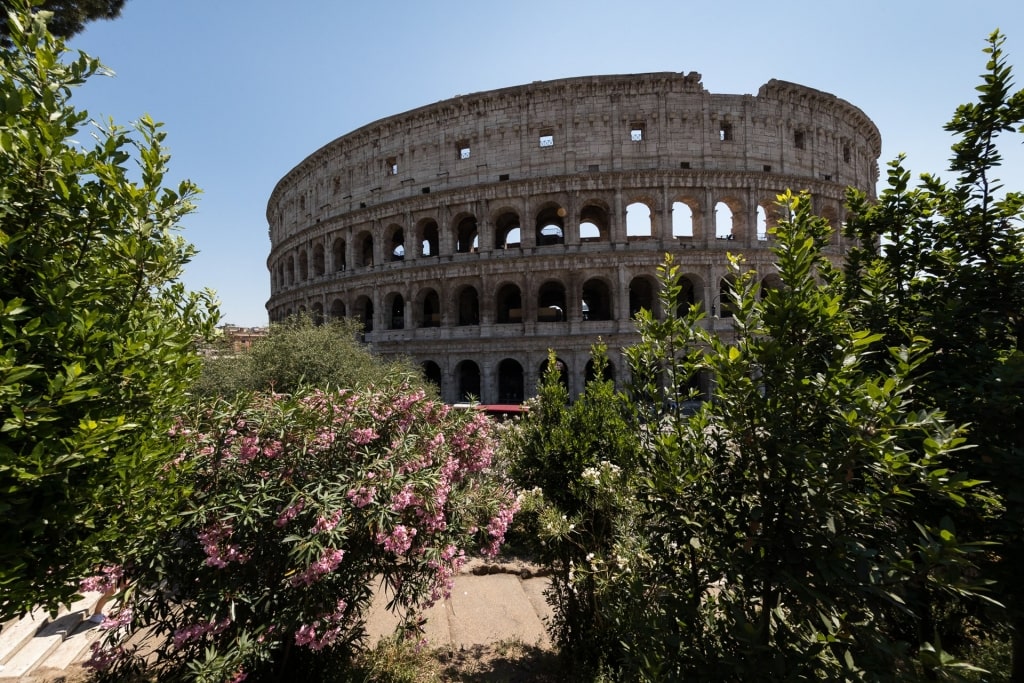
Colosseum in Rome, Italy
Not only is it one of the most famous landmarks in Europe, but Rome’s Colosseum is also an enduring symbol of the ancient world. Indeed, the enormity of the Colosseum is as much a thing to behold today as it was when it was constructed nearly two thousand years ago, on order of emperor Vespasian in AD 72. The Roman landmark was ultimately completed by his son and successor Titus in AD 80 and was then known as the Flavian Amphitheatre.
Located just east of relic-littered Palatine Hill in Rome, the massive stone and concrete structure measures 160 feet tall with a circumference of 1,788 feet—a mind-boggling scale for the times. Contemplate it while walking its perimeters, taking note of the travertine-clad walls and trio of tiered seating levels, with arches capped by differing column styles (Doric, Ionic, and Corinthian). Note that above, a massive retractable velarium, or awning once shielded spectators from the elements.
Inside the engineering feat of its elliptical bowl, you can imagine ancient scenes from the gladiators and wild beasts that once battled here at the height of the Roman Empire, where some 50,000 spectators took in brutal and gory scenes of combat.
Parthenon, Athens, Greece
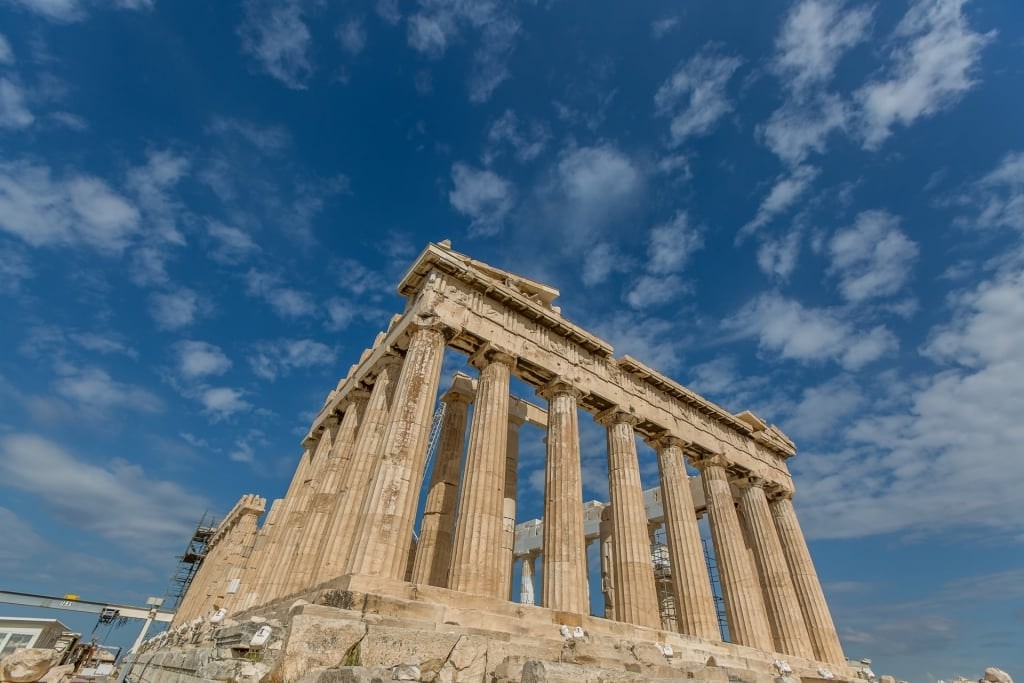
Parthenon in Athens, Greece
Another icon of European antiquity, the cream-colored, marbled Parthenon temple is the crowning glory of Athens’s rocky Acropolis hilltop (the sacred heart of the ancient city). The picture-perfect shrine features a harmonious colonnade of Doric columns and belvedere overlooking Athens.
One of the most important Greece landmarks, the monument was commissioned by the Athenian statesmen Pericles in dedication to Athena Parthenos, the patron goddess of Athens (a massive gold-and-ivory statue depicting her likeness was once contained within) as well as to serve as the city’s treasury. Much of what remains of the temple today dates back to the mid-5th century BC.
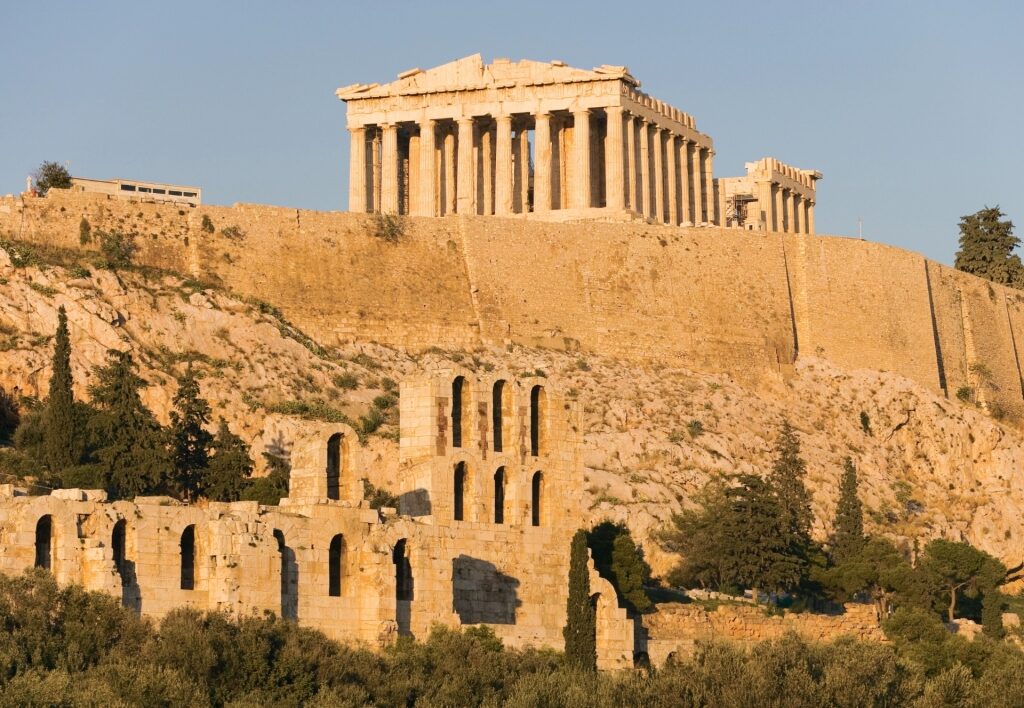
Acropolis in Athens, Greece
A steep ascent on foot atop the Acropolis marks a journey back in time to the cradle of Western Civilization. Here, among the scattered Greek ruins of ancient days, the 2,500-year-old Parthenon, set at the crest of the Acropolis, remains supreme.
As a matter of conservation, visitors are not allowed inside the monument. However, taking in the exterior does not disappoint, with its 46 graceful columns and perch for sweeping city views.
To better imagine what the interior of the temple was once like, you can see numerous statues and artifacts that were once temple adornments in the nearby Acropolis Museum. There, too, you’ll see a reproduction of the temple’s missing friezes, including of the so-called Elgin Marbles, which are currently displayed at London’s British Museum, to ongoing controversy.
Sagrada Família, Barcelona, Spain
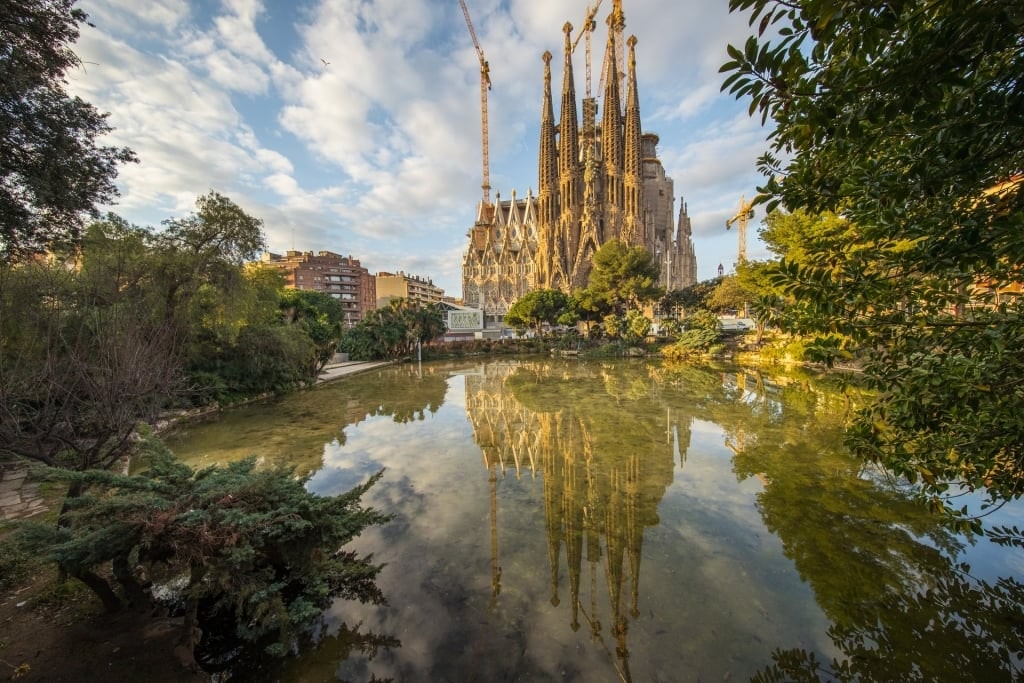
Sagrada Família in Barcelona, Spain
The unparalleled achievement and obsession of celebrated Spanish architect Antoni Gaudí, Sagrada Família in Barcelona is among the most famous landmarks in Europe—not to mention one of the grandest churches to ever grace planet Earth. One of a kind and constructed on a larger-than-life scale, the neo-Gothic/Art Nouveau basilica remains a work in progress for more than a century after its construction began in 1882.
One of the most beautiful places in Spain, the exterior is a wild display of intricate spires, towers, carvings, and sculptures that stretch skyward, to heights of 566 feet. Zoom in to pick out fine and fantastical details carved in stone—flora and fauna, nativity scenes and biblical stories, and gargoyles and dragons abound.
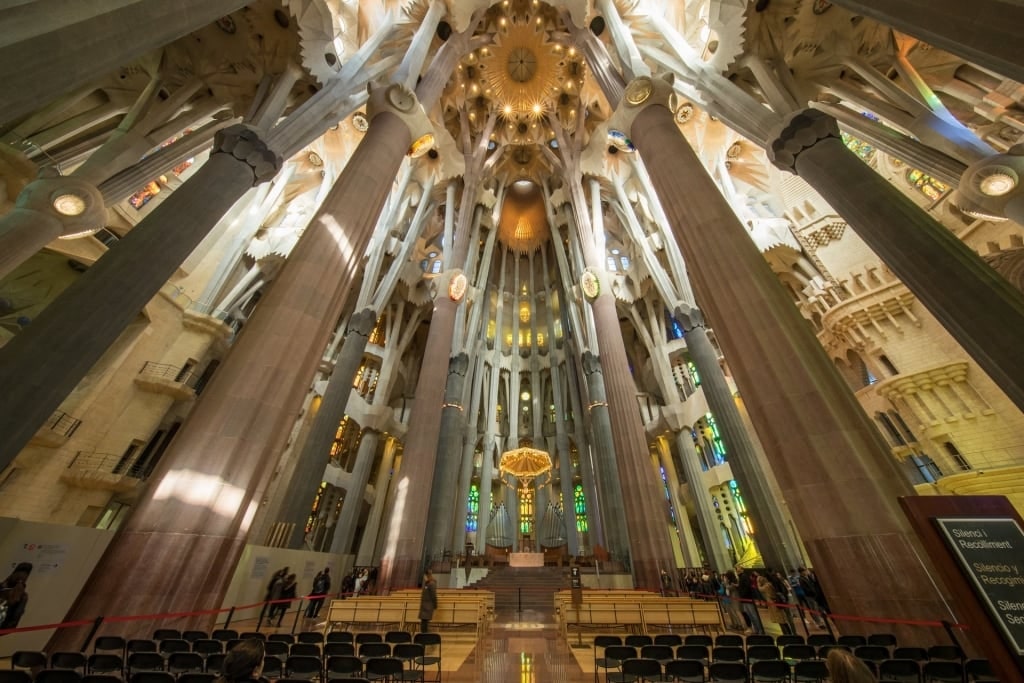
Sagrada Família in Barcelona, Spain
Contemplating the structure’s soaring interior, with massive, twisting pillars reaching toward the central nave in a scene reminiscent of a forest canopy, might just make a believer out of the faithless (there’s room for 9,000 seated congregants to sit down and ponder).
Finally, the long-awaited target date for the completion of this building is within reach: 2026, which will mark a century after Gaudí’s death (he’s buried in the crypt underneath).
Read: Three Days in Barcelona
Stonehenge, UK
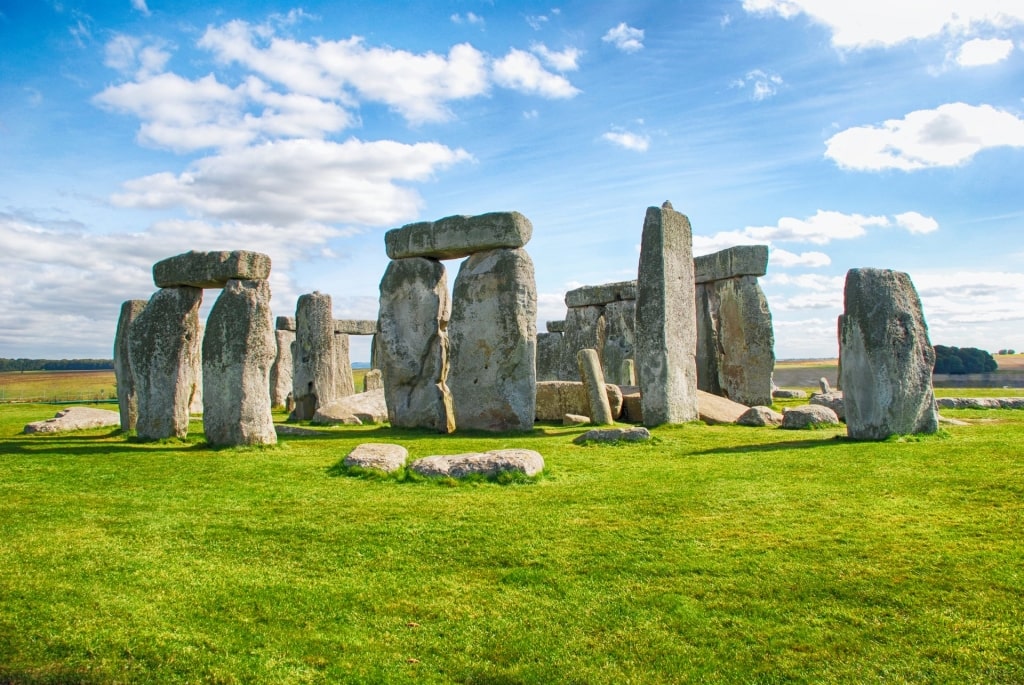
Stonehenge, UK
Mammoth and mysterious, this ancient circle of megalithic pillars in the English countryside, on Salisbury Plain, has fascinated generations of curious spectators. Widely touted as the most important prehistoric monument in Britain, with roots stretching as far back as 3000 BC, questions surrounding the significance of the site and its construction remain today.
Some historians say it was an astronomical observatory (the stones are perfectly aligned to the solstice sunrise/sunset). Others believe it was a ceremonial burial site. For engineers, the most peculiar aspect of the site is the heavy bluestone and sarsen stones themselves (weighing as much as 45 tons), some of which were moved great distances from as far away as neighboring Wales.
See what echoes of the past are revealed to you on a visit to the storied archaeological site—just keep in mind that you’ll have to ponder the mysterious monoliths from a distance, as it’s not permitted to touch the stones.
Leaning Tower of Pisa, Pisa, Italy
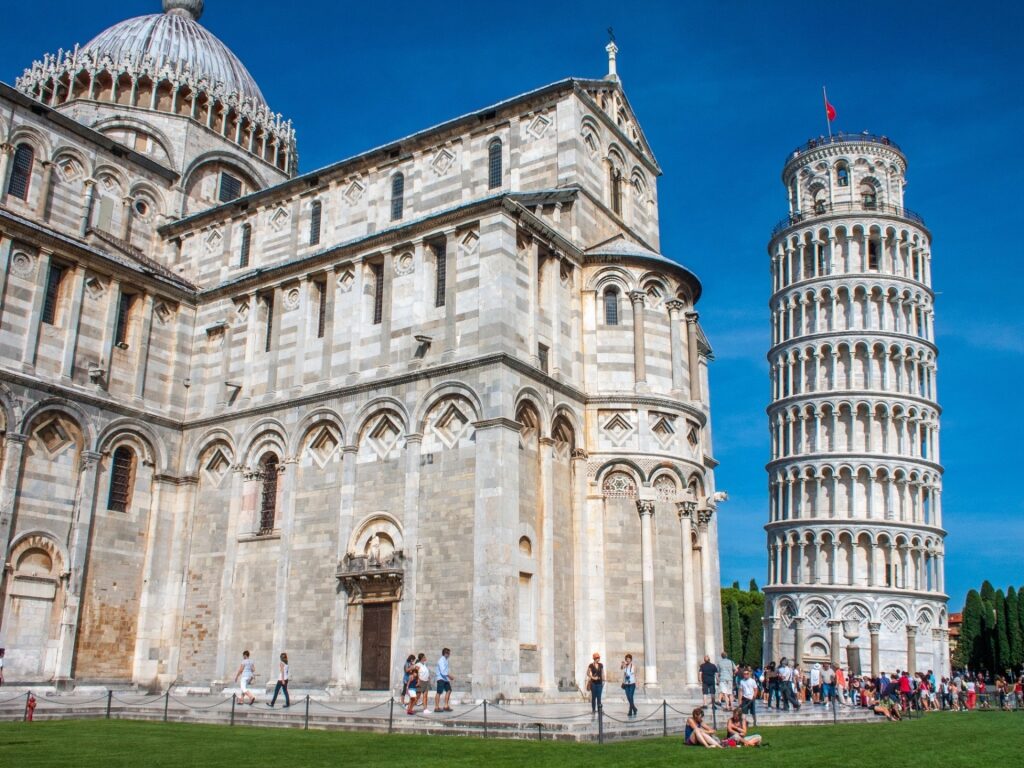
Leaning Tower of Pisa, Italy
Dating to 1173, this curious bell tower for the Pisa Cathedral in Pisa, Italy, was lopsided almost from the start, owed to the uneven settling of its foundation in the soft ground below. Architects over the centuries have tried (in vain) to compensate for the lean, but some 850 years later, the 185-foot-high Leaning Tower of Pisa leans (to some 4 degrees off the vertical) indeed.
But, alas, that’s what has made it one of Italy’s signature sights and one of the most famous monuments in Europe. Happily, attempts to stabilize the eight-story medieval tower, with its white-marble arcades, have helped ensure that it’s still stable and safe to climb the 251 interior steps for visitors today. You’ll get some nice views of the cathedral complex and surrounding Tuscan scenery from the top.
St. Peter’s Basilica, Vatican City, Italy
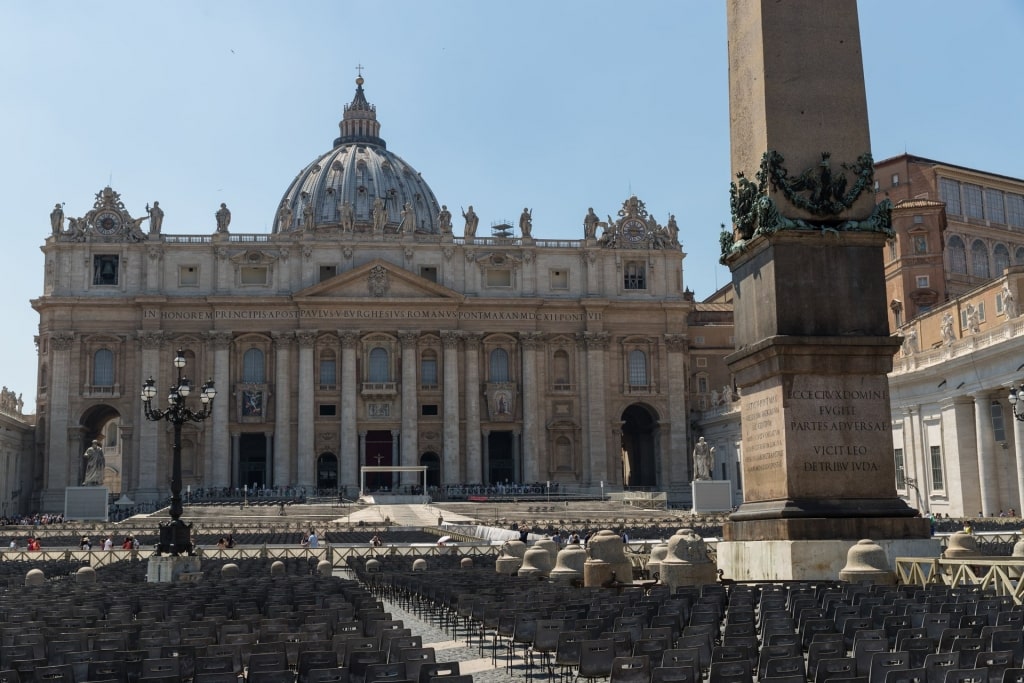
St. Peter’s Basilica in Vatican City, Italy
St. Peter’s Basilica, in the Vatican City (an enclave in Rome), is a principal shrine for the Catholic faith and the largest Christian church in Europe, marking a point of pilgrimage for Catholics the world over. But you needn’t be devout to appreciate the history and grandeur of the site.
Built atop St. Peter’s tomb, the Renaissance-style basilica was crafted in reverence to Jesus’s most prominent apostle, who became the first pope (and who is believed to have been crucified on an adjacent site during Roman times). The original foundations of this Roman church date to the 4th century AD (which was commissioned by Emperor Constantine), with a newer basilica built on top and further embellished by Italian masters throughout the 16th and 17th centuries.
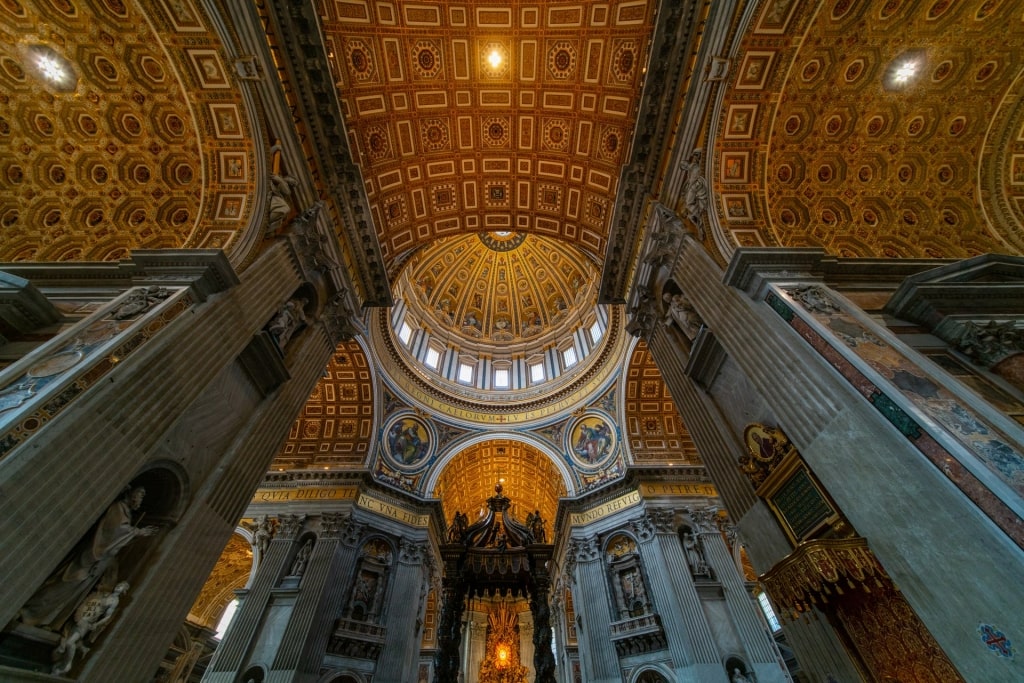
St. Peter’s Basilica in Vatican City, Italy
In the cavernous interior, a veritable treasure trove awaits, where marble and gilt meet a skyward dome and rich Renaissance and Baroque artwork from masters like Raphael, Michelangelo, and Bernini. Showstoppers include Michelangelo’s graceful Pietà, Bernini’s bronze baldachin over the papal altar, and Michelangelo’s 448-foot-high dome. Climb (or take an elevator ride) up for a closer look at the massive dome’s detailing—with bonus Vatican City views. Visits to the papal tombs in the Vatican grottoes and to the tomb of St. Peter can also be arranged.
Out front, the elliptical, colonnaded, Bernini-designed piazza stands in the shadow of St. Peter’s façade—this is also the setting for regular papal audiences, filled in with pilgrims who gather here for blessings from the head of the Roman Catholic church.
Pantheon, Rome, Italy
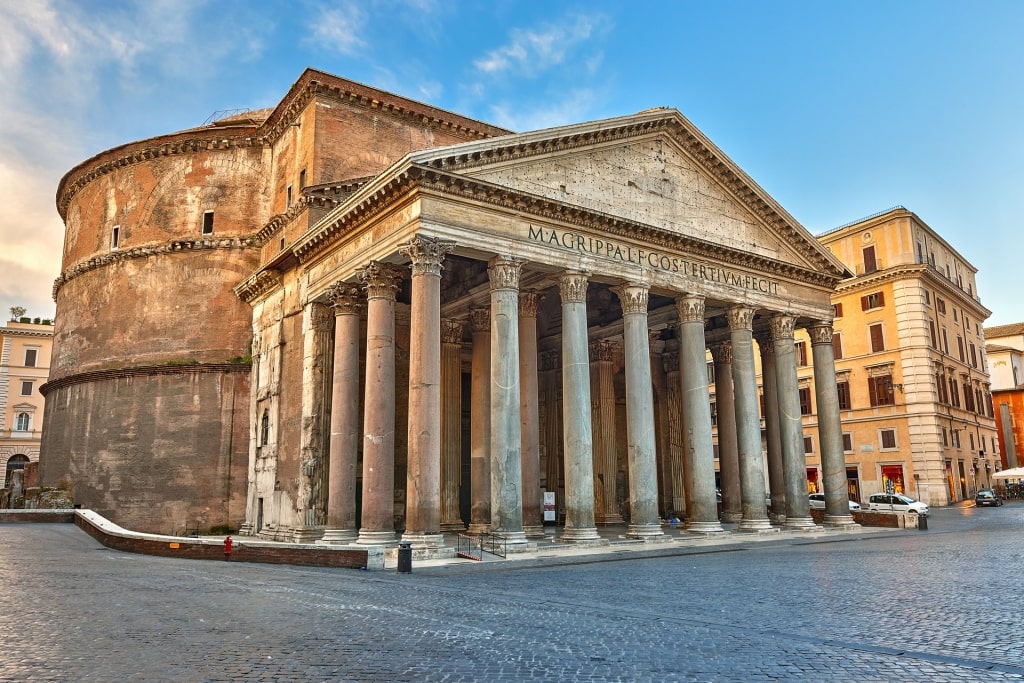
Pantheon in Rome, Italy
Ancient Roman temple turned Catholic church, Rome’s well-preserved Pantheon—derived from the Greek words pan (all) and theos (gods)—has been wowing mortal (and perhaps immortal) crowds for over two millennia. Originally built in 27 BC by the statesman Agrippa before being reconstructed in the early 2nd century AD, under order of Emperor Hadrian, this glorious relic of ancient Rome remains remarkably intact.
Step inside the oversized bronze double doors and beyond the imposing 16 Corinthian columns standing guard outside to really grapple with the massive scope of this architectural marvel. Measuring a perfect 142 feet wide by 142 feet high, its harmonious dimensions incorporate a soaring concrete dome punctuated by a 27-foot-wide oculus (which was meant to bring in light and represent a connection between the temple and the gods).
Once you stop craning your neck, do seek out the tombs of Italian kings Vittorio Emanuele II and Umberto I and of Renaissance artist Raphael that lie inside—not a bad final resting place.
Alhambra Palace, Granada, Spain
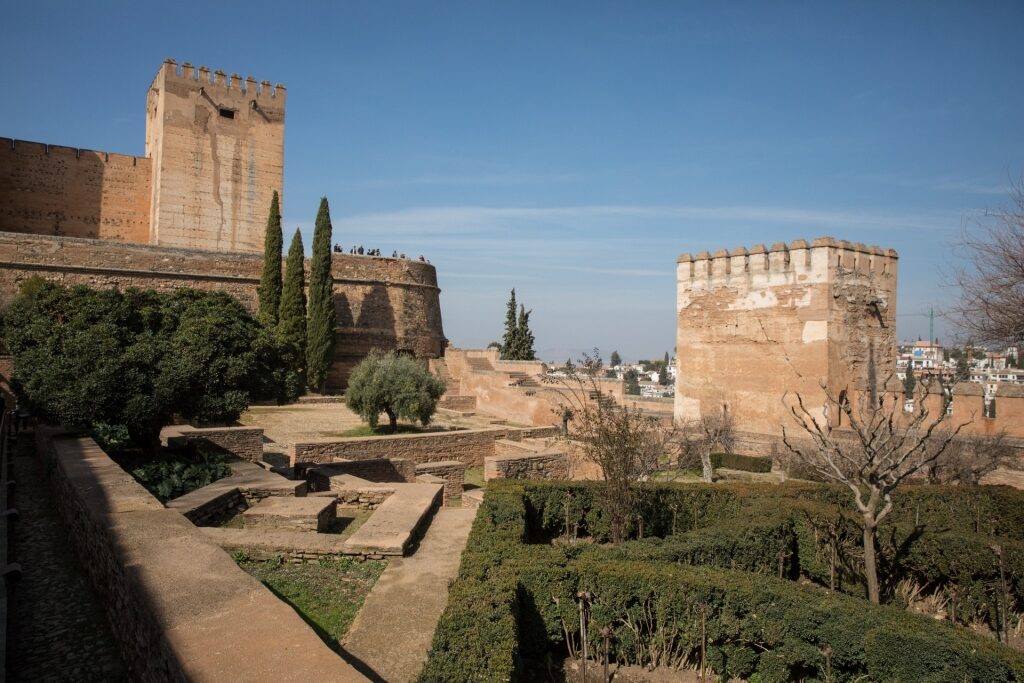
Alhambra Palace in Granada, Spain
The Alhambra, overlooking the city of Granada against a backdrop of the craggy Sierra Nevada mountains, is regarded as the world’s most exquisite example of Moorish architecture.
The Moors inhabited much of Southern Spain and Portugal from 711 AD to 1492 AD. They were Muslim tribes from North Africa who brought with them a rich culture, evidence of which remains all over Southern Spain today.
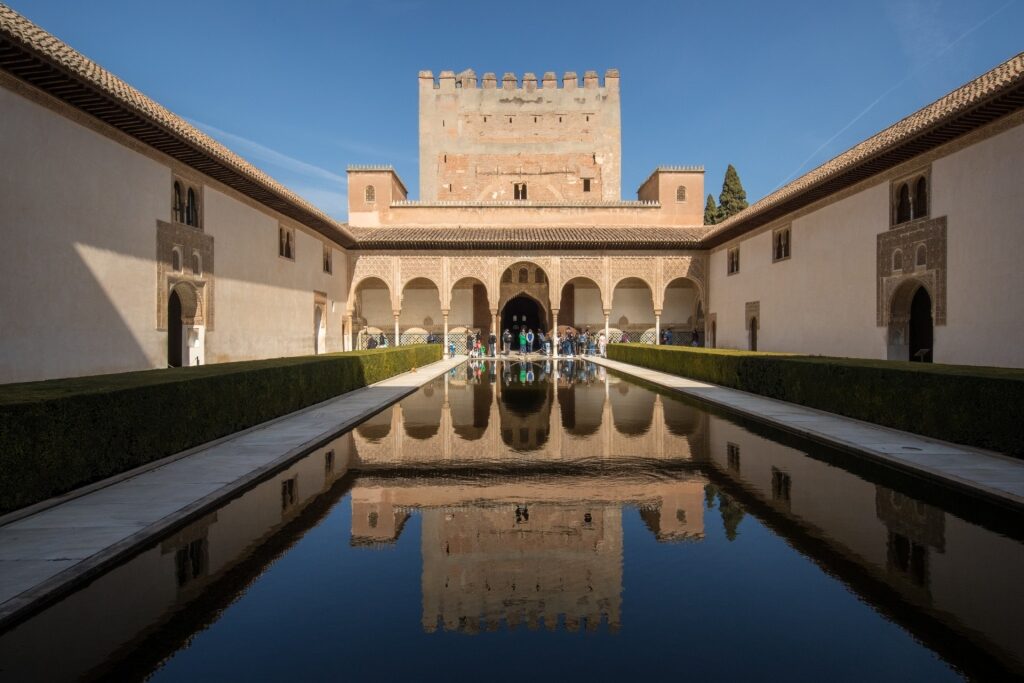
Alhambra Palace in Granada, Spain
The Alhambra, named after its dusky pink hue, was once a walled citadel. Much of what you see today dates from the 13th and 14th centuries, when the castle was transformed into an opulent palace, the home of the Nasrid emirs.
Other parts are more recent; the Renaissance Palacio de Carlos V was built in the 15th century by the emperor Carlos V, who ordered a palace to be constructed here once the Moors had been expelled. Check out the Museo de la Alhambra inside the palace, which is packed with beautiful artifacts from the time of the Moors.
Arguably the most striking section of the Alhambra is the Palacios Nazaries, with intricately carved ceilings and jaw-droppingly gorgeous mosaics. But there are so many details to admire; the fragrant Patio de los Arrayanes, or Courtyard of the Myrtles, with myrtle hedges framing a shimmering pool, and the elaborate cedarwood ceiling of the Salon de los Embajadores.
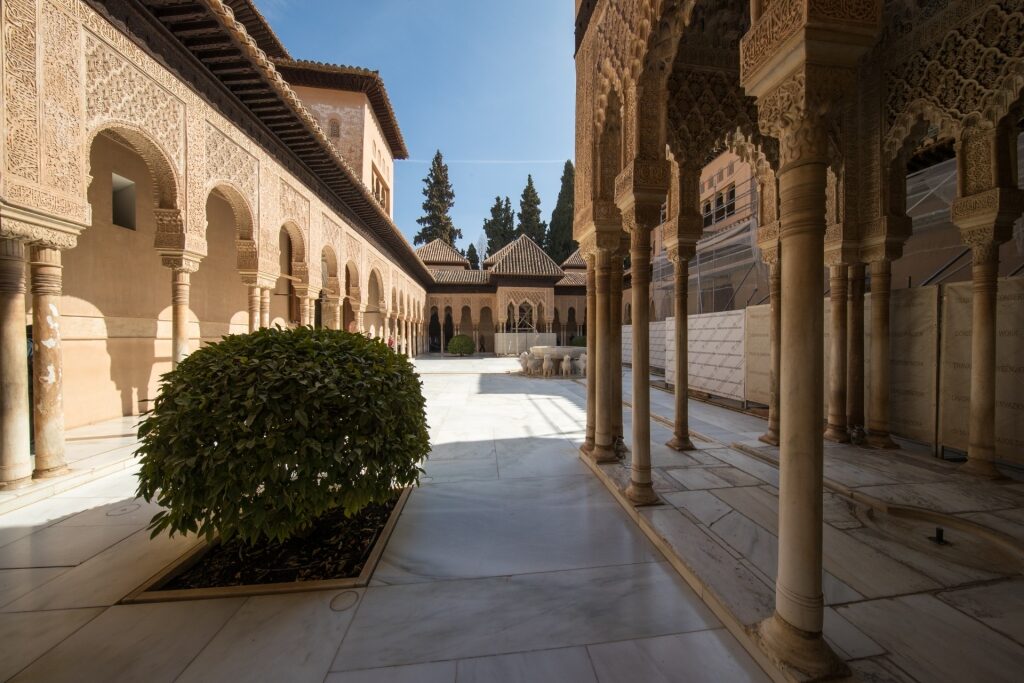
Alhambra Palace in Granada, Spain
On the Patio de los Leones, the Lion Courtyard, 12 marble lions dating to the 11th century circle a fountain. The whole space is surrounded by delicate columns.
While you’re here, don’t miss the Generalife, a magnificent 14th-century garden laid out with trees, reflecting pools, and splashing fountains. If anything sends you home with a desire to add a little Moorish style to your own backyard, it will be this.
Hagia Sophia, Istanbul, Turkey
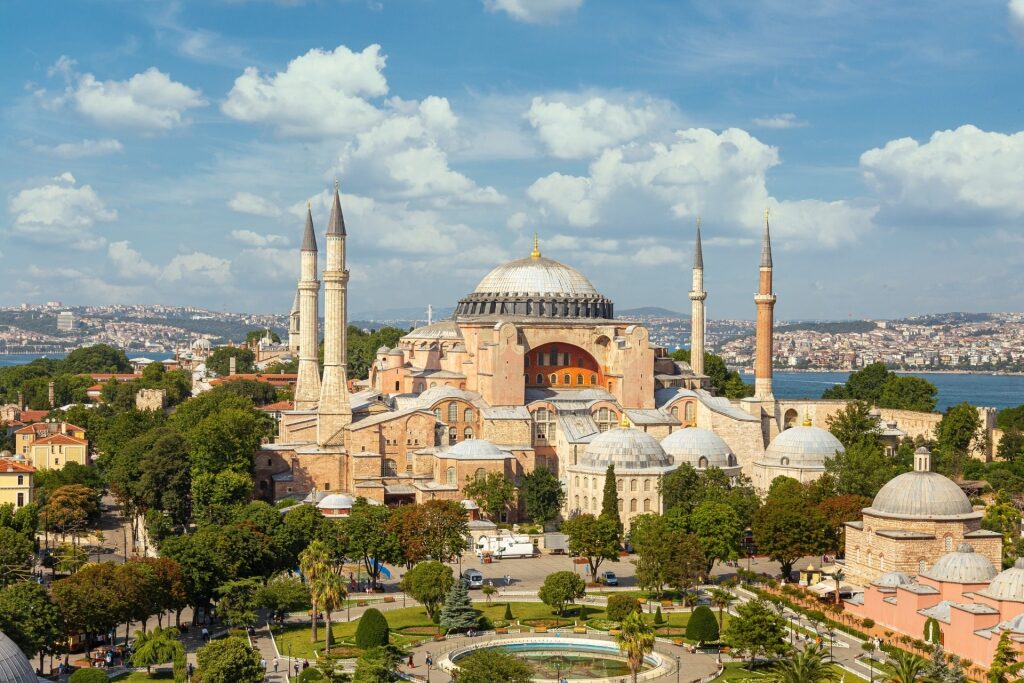
Hagia Sophia in Istanbul, Turkey
The delicate minarets of Hagia Sophia pierce the distinctive Istanbul skyline, while its vast dome is a symbol of the city’s spectacular Byzantine heritage. If you’ve visited Istanbul in the past, you could be forgiven for being confused about the status of this magnificent building, which has changed several times over the years.
Its first iteration was built in 537 AD as a church named Hagia Sophia. The construction of the vast dome alone involved 10,000 workers. Hagia Sophia remained the largest enclosed space in the world for nearly 1,000 years.
Mehmet the Conqueror changed the building to a mosque in 1453, and it stayed as such until 1935, when it became a museum under the reign of President Atatürk.
In 2020, the building was once again converted into a mosque; you’ll also see it named Aya Sofia, which is the Turkish spelling. These different uses mean there’s both Christian and Muslim symbolism decorating the building.
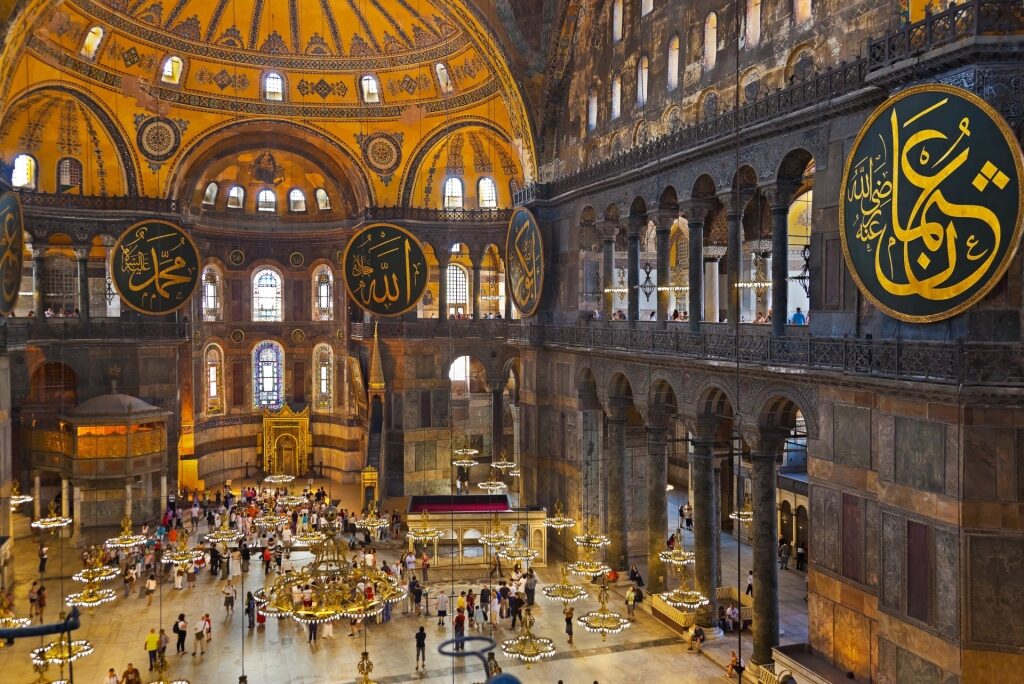
Hagia Sophia in Istanbul, Turkey
The attention to detail and the astonishing engineering are mind-blowing. Marble was brought from Syria, Marmara, North Africa, and further parts of Turkey in shades of green, pink, yellow, and white. Columns were imported from the Temple of Artemis in Ephesus. The walls are covered with dazzling mosaics in gold, silver, jewel-like stones, and terracotta.
As Hagia Sophia is now a working mosque, there are some areas on the ground floor inaccessible to non-Muslims. But you can visit the Upper Galleries, rich in shimmering mosaics, and you’ll have an excellent perspective of the vastness of the dome.
You’ll need to dress modestly, and women are required to wear a headscarf to enter. But a visit to what’s widely regarded as the eighth wonder of the world is an absolute essential when in Istanbul.
Nyhavn, Copenhagen, Denmark
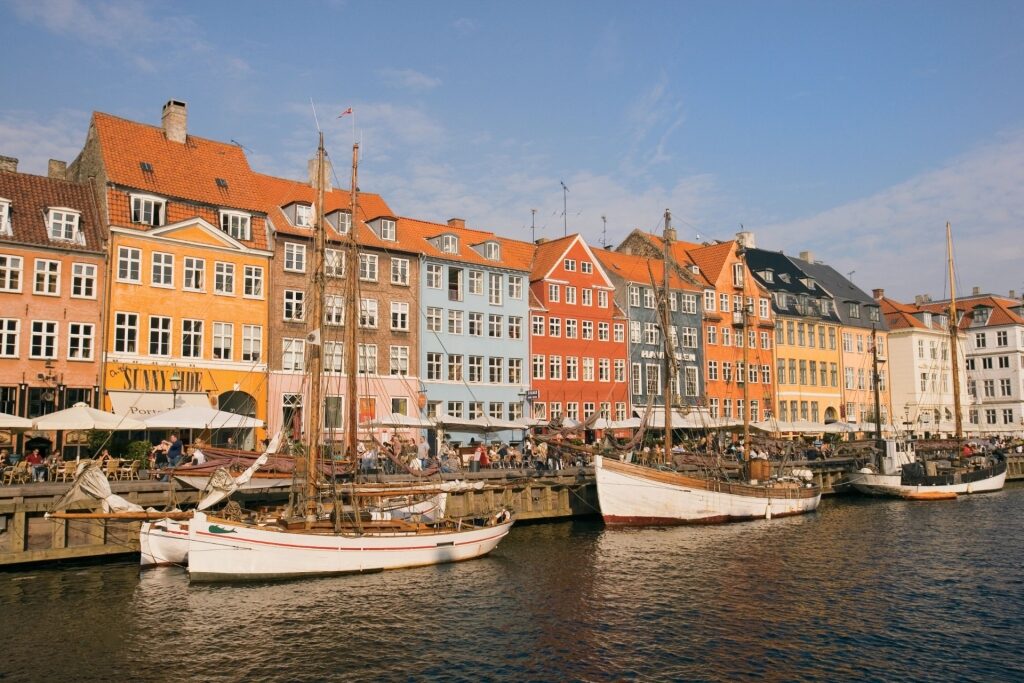
Nyhavn in Copenhagen, Denmark
The colorful, gabled facades of Nyhavn’s waterfront, the buzz of the beer gardens, and the boats bobbing on the water is one of the most iconic visions of Copenhagen. Visitors love the jaunty red, yellow, blue, and green facades, while locals see the canal as a favorite spot for cold beers on a hot summer’s day.
Nyhavn, which translates as “New Harbor”, dates back to the 17th century. It’s actually a canal, built to connect Kongens Nytorv, a public square, to the city’s main harbor. Then, Nyhavn was a commercial port—and with commercial ports in those days came pubs, boozing, and houses of ill repute.
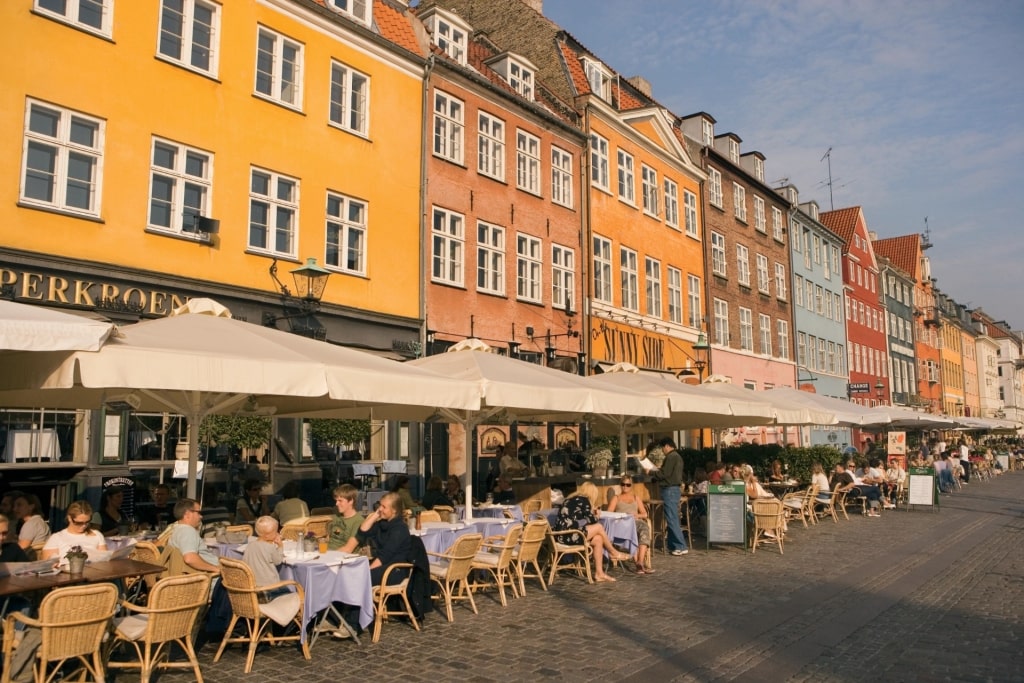
Nyhavn in Copenhagen, Denmark
Today, of course, Nyhavn has cleaned up its act. You won’t see commercial ships here, just wooden sailboats and canal tour boats. The facades of the houses have been beautifully renovated, and the waterfront is lined with restaurants, bars, and sidewalk cafés.
As you stroll around, turn your thoughts to Hans Christian Andersen, Denmark’s famed fairytale writer. He lived at no. 20, and then later at no. 67 and no. 18, writing stories including The Princess and the Pea and The Tinderbox. Take a look, too, at no. 9, the oldest building on Nyhavn, built in 1681.
Edinburgh Castle, Scotland

Edinburgh Castle, Scotland
Clinging to a volcanic plug, its impenetrable walls snaking around the brooding Castle Rock, Edinburgh Castle is one of the most famous landmarks in Scotland. A former royal residence, today it’s an active military base and the home of Scotland’s priceless Crown Jewels, called the Honours of Scotland.
A fortification has stood on Castle Rock since the Iron Age, but parts of the castle as you see it today date back to the 11th century. Queen Margaret died here in 1093. Her son, King David I, built a chapel in her honor in the Romanesque style. It’s now Edinburgh’s oldest building and a popular wedding venue.
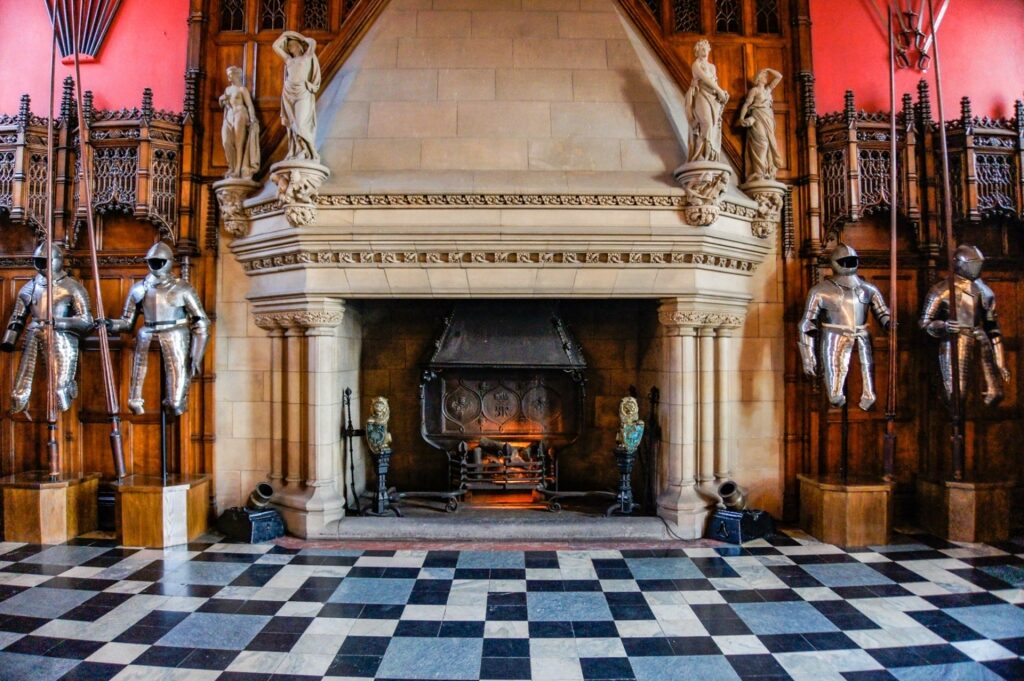
Great Hall in Edinburgh Castle, Scotland
Later additions include the Great Hall, built in the early 16th century by James IV, and the Half Moon Battery, also added in the 16th century. The Scottish National War Memorial dates back to just after the First World War.
A visit typically includes the Honours of Scotland, the oldest crown jewels in the United Kingdom, dating back to the coronation of Mary, Queen of Scots in 1543. Another popular attraction is Mons Meg, a massive siege gun from the 15th century that could hit a target two miles away.
The Royal Apartments are packed with historic interest, including portraits of kings and queens and the closet where Mary, Queen of Scots gave birth to James VI of Scotland, also James I of England. Visit the Great Hall, completed in 1511, and the elaborate Scottish War Memorial.
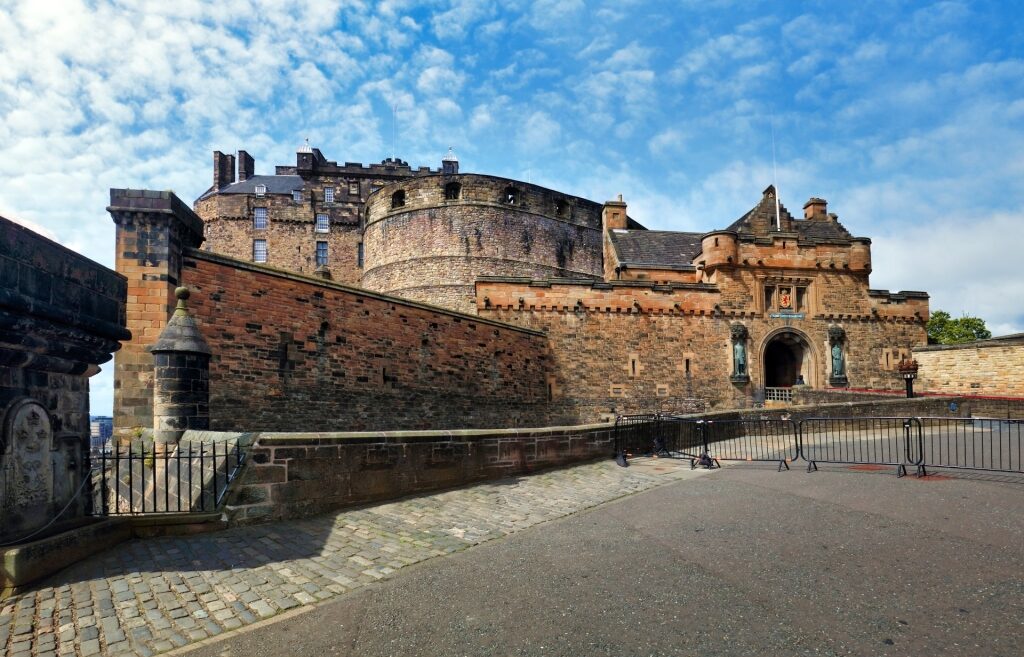
Edinburgh Castle Esplanade, Scotland
The Esplanade parade ground is relatively modern, having been established in 1820, while the National War Museum, inside the castle walls, charts 400 years of Scotland’s complex military history.
Read: Best Places for Solo Travel in Europe
Mont-Saint-Michel, Normandy, France
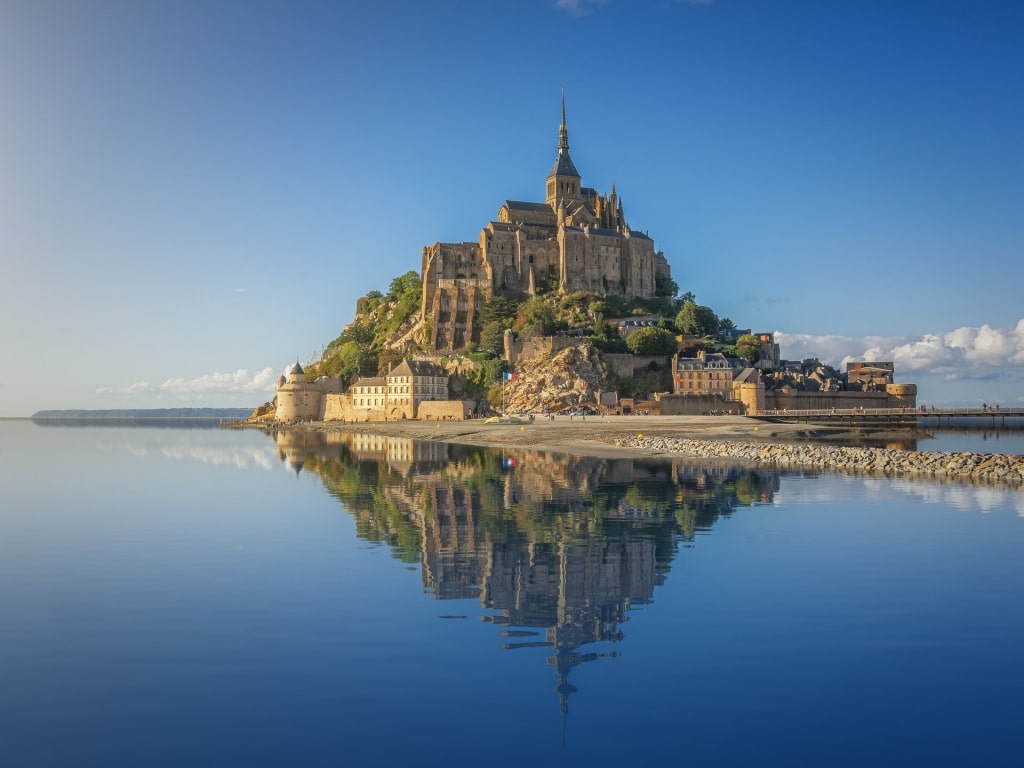
Mont-Saint-Michel in Normandy, France
Mont-Saint-Michel is a spectacular medieval wonder built between the 11th and 16th century. A hybrid abbey-fortress, this historical French landmark combines the best in religious devotion and military might.
Rising above a rocky island, the soaring spires and delicate Gothic arches are immediately recognizable as a European landmark. A fortified village clings around it, with ramparts that repeatedly kept the villagers safe during sieges in the Hundred Years’ War.
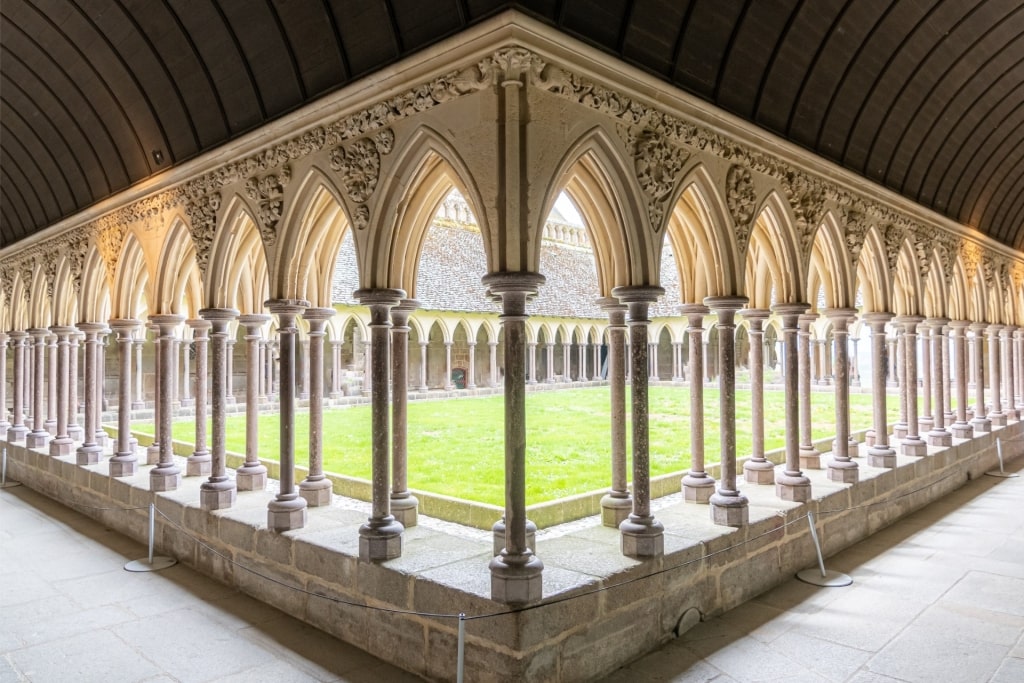
Mont-Saint-Michel, Normandy, France
Tides rising and falling up to 40 feet affect the bay in which Mont-Saint-Michel stands, turning it into an island. This added isolation adds to its mystique and air of spirituality.
The Benedictine abbey attracts more than two million visitors every year, many of them pilgrims. They all come away having seen something of medieval monastic life and one of France’s most dramatic coastal landscapes.
Palace of Versailles, France
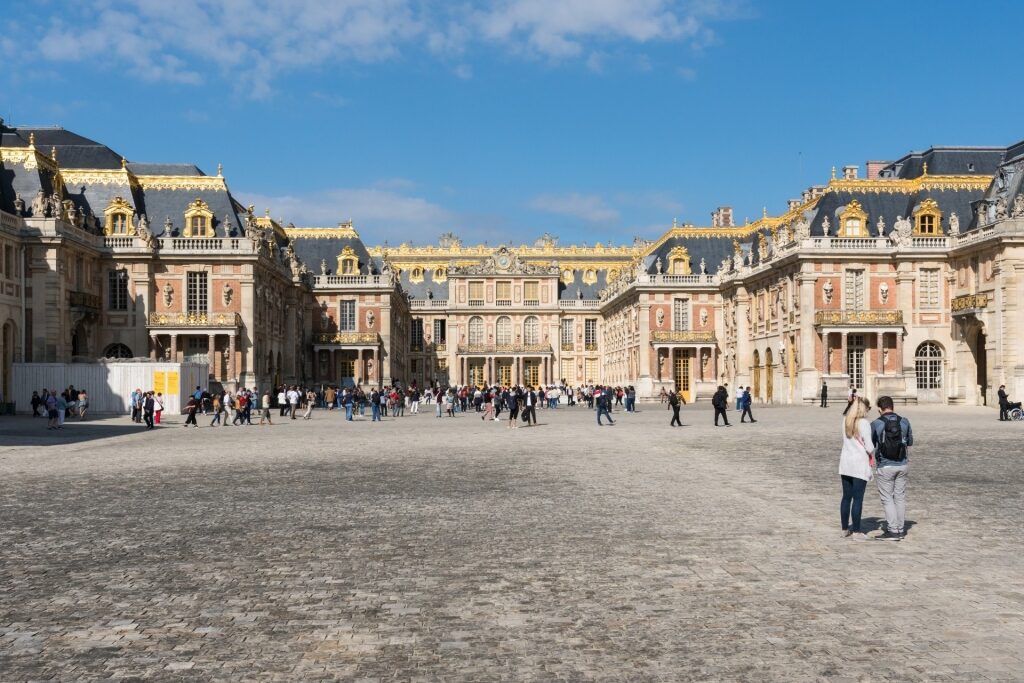
Palace of Versailles, France
Versailles has become a byword for royal luxury and an extravagant way of life. Its Baroque architectural splendor was a model for other royal palaces and five-star hotels around the world.
Originally a modest hunting lodge, Versailles was transformed by King Louis XIV into Europe’s most magnificent royal residence by 1682. Among its 2,300 rooms were such wonders as a Hall of Mirrors—the 1919 venue for the treaty ending the Great War.
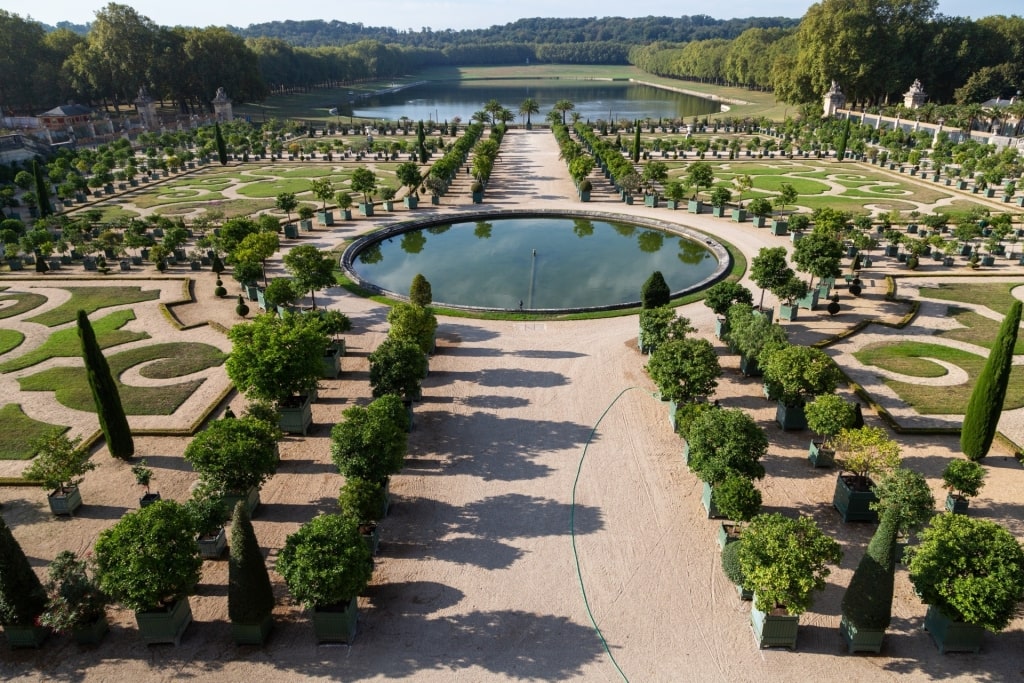
Palace of Versailles, France
The estate’s vast gardens are equally impressive, with 50 fountains and impeccably manicured shrubbery. In the grounds is Marie Antoinette’s Hameau de la Reine, an idealized farm village with its own lake.
Recognized as a UNESCO World Heritage Site in 1979, Versailles showcases the height of French craftsmanship and architecture. That such detached excesses may have led directly to the French Revolution is also an inescapable thought.
Read: One Day in Paris
Belém Tower, Lisbon, Portugal
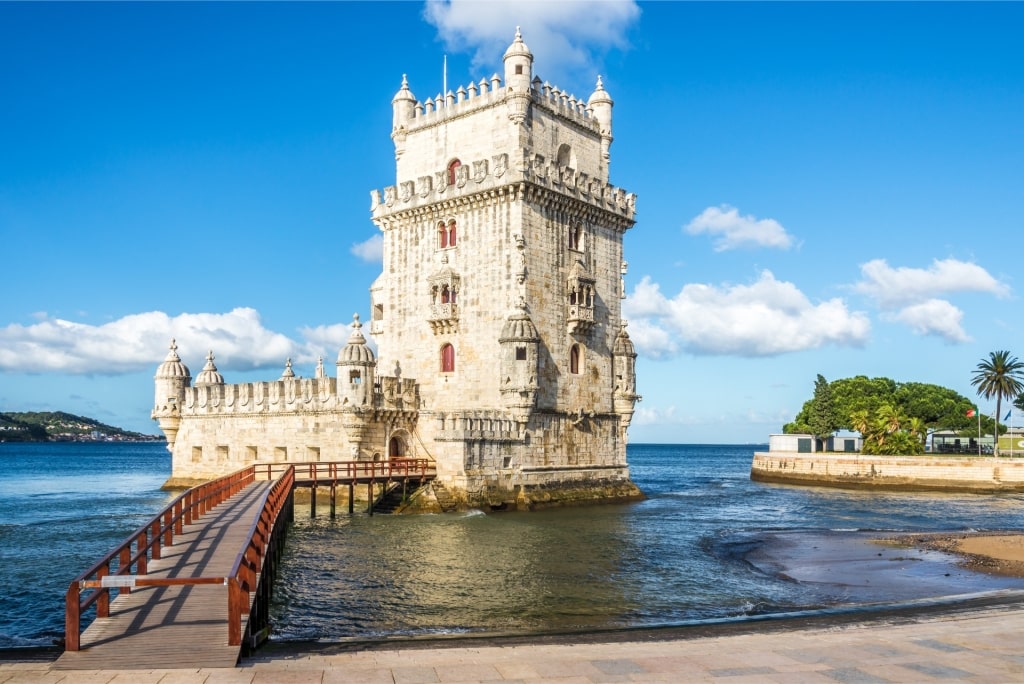
Belém Tower in Lisbon, Portugal
Standing at the mouth of the Tagus River, Belém Tower in Lisbon looks out on a world that once belonged to Portugal’s explorers. The country’s Age of Discovery saw its seafarers conquer North Africa, sail around the Cape of Good Hope, and make the return trip from Asia with precious spices.
The tower was built in 1519 to mark that historic voyage to India by Vasco da Gama. Its exuberant Manueline architecture with exotic Moorish features completely captures the enthusiasm and achievements of the age.
Originally standing on a small island in the harbor as a defensive bulwark, the tower was also a ceremonial gateway to Lisbon. Along with the nearby Jerónimos Monastery, where explorers prayed before and after their voyages, it is a UNESCO World Heritage site.
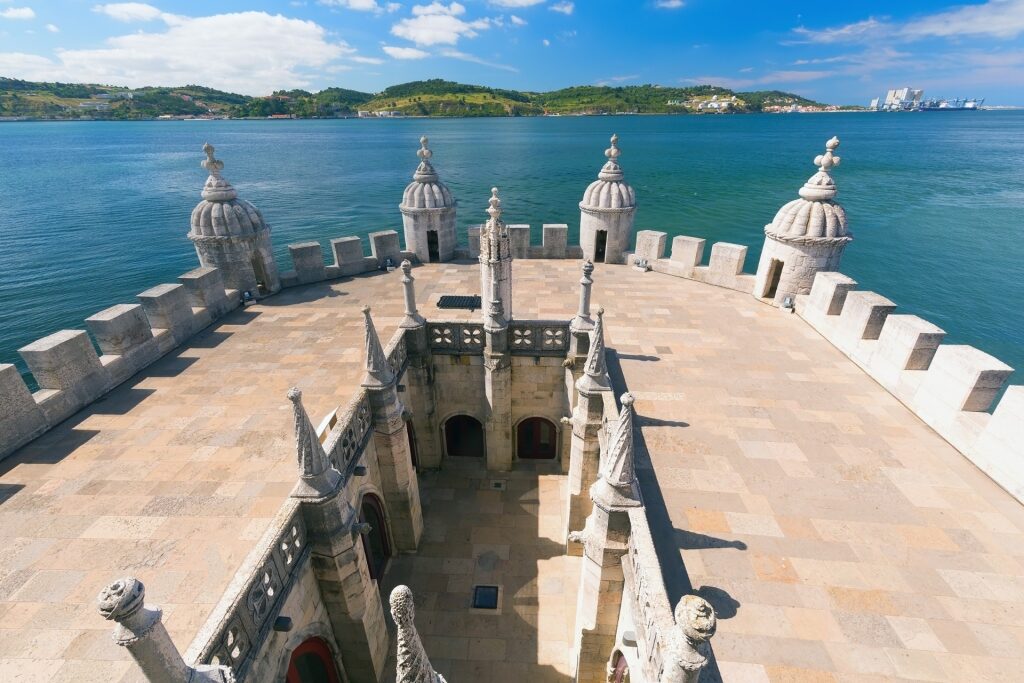
Belém Tower in Lisbon, Portugal
You can visit the four-story interior and climb to a rooftop terrace for panoramic views—one of the best things to do in Lisbon. A balcony allowed dignitaries to welcome arriving fleets and a little imagination can easily conjure up the grandeur of the scene.
Acropolis of Lindos, Rhodes, Greece
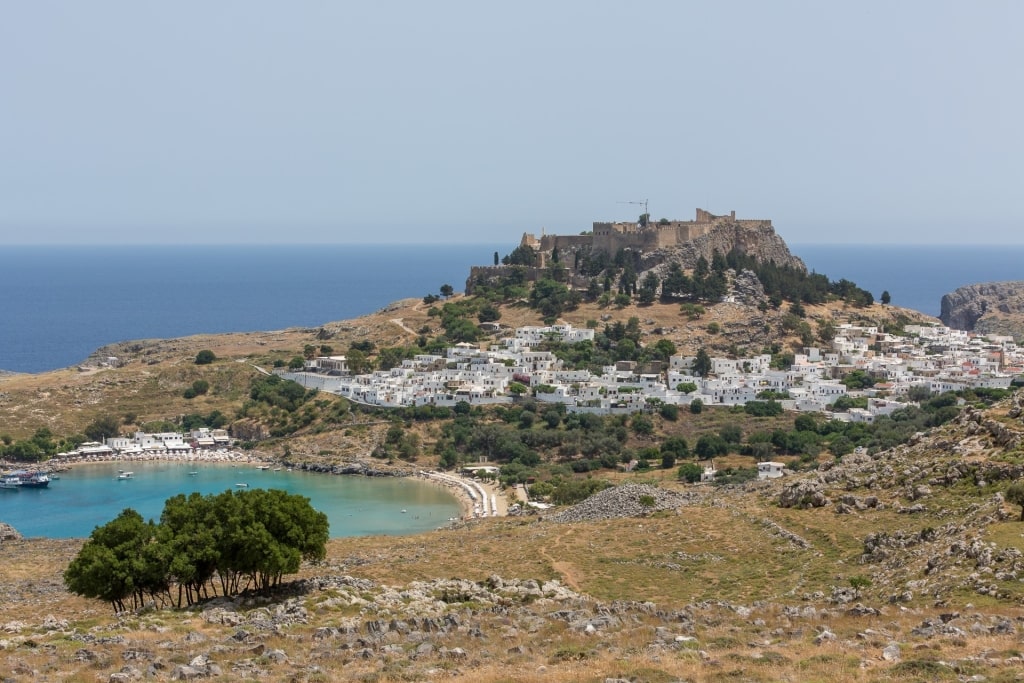
Acropolis of Lindos in Rhodes, Greece
Combining elements of ancient Greek, Roman, Byzantine, and medieval style, the Acropolis of Lindos is an archaeological wonder. Its setting on a high cliff over the Aegean Sea on the island of Rhodes is a giddying bonus.
The centerpiece is the fourth-century BCE Doric Temple of Athena Lindia, where Alexander the Great is said to have made offerings. Another must-see is a third-century BCE carving of a trireme, a three-deck rowed warship.

Acropolis of Lindos in Rhodes, Greece
In Byzantine times, part of the complex was converted into a church. In the 14th century, massive walls and towers were added by the Knights of St. John.
You climb to the acropolis, on foot or on a donkey, through village lanes lined with whitewashed houses. At the top, you have photogenic views across Lindos Bay to the sparkling Aegean.
Old Town of Tallinn, Estonia
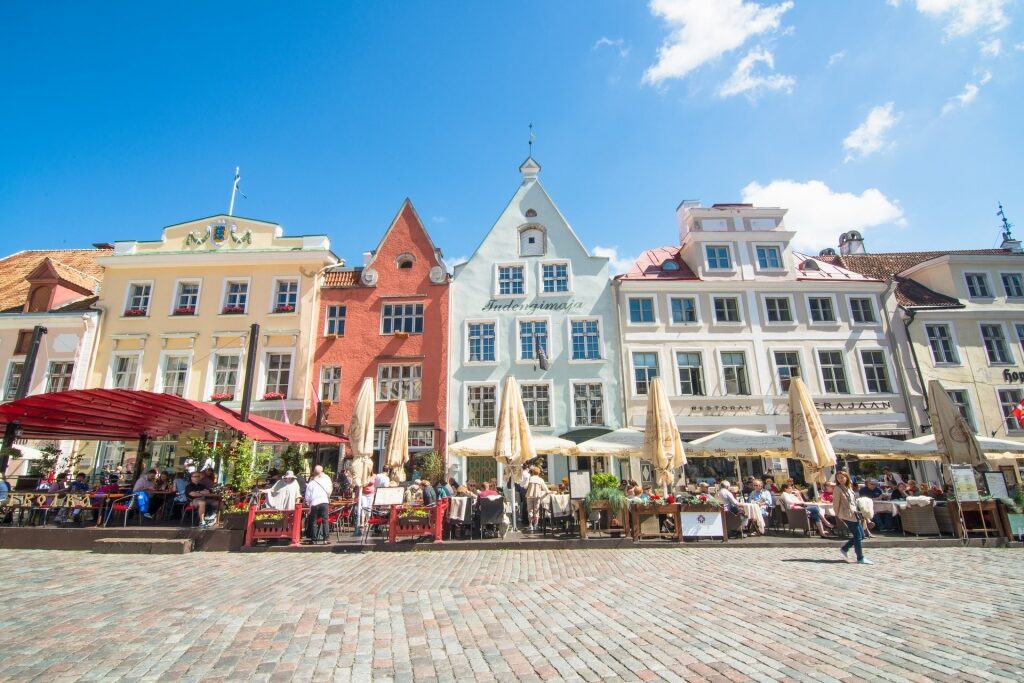
Old Town of Tallinn, Estonia
Tallinn’s Old Town is one of northern Europe’s most completely preserved medieval settlements. Even its 13th-century town walls are intact, including its many towers, bastions, and gates.
You can walk part of that wall, including defensive towers with names such as “Fat Margaret”. You’ll enjoy views over red-tiled roofs, church spires, and streets full of picturesque apothecaries, hidden courtyards, and cozy taverns.
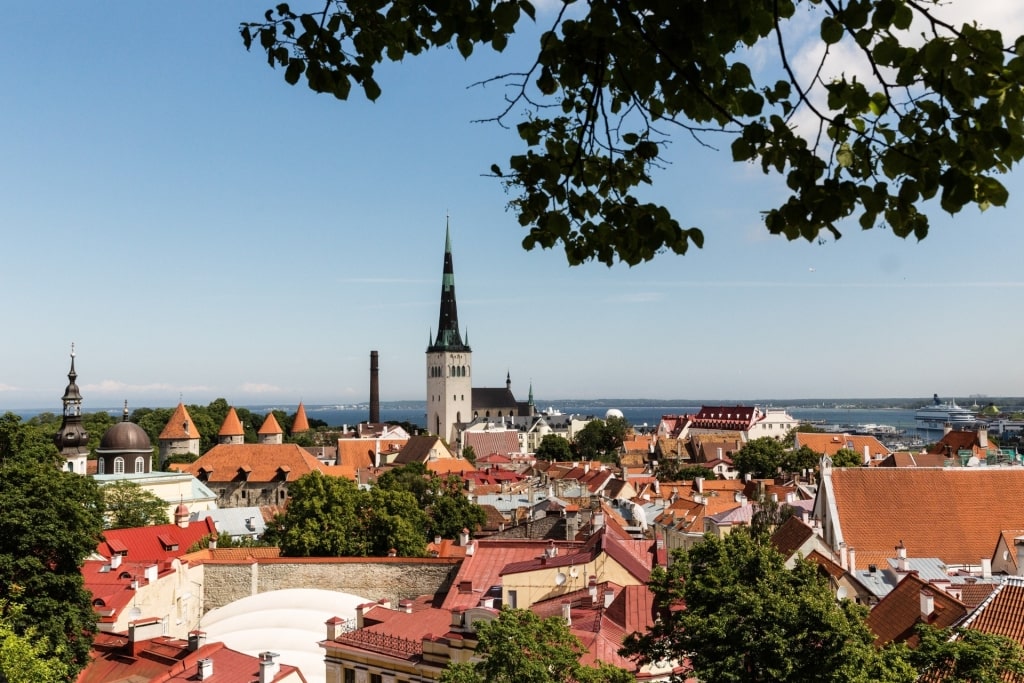
Old Town of Tallinn, Estonia
Founded by Danish invaders in 1219, the town was later a key hub of the Hanseatic League. That wealth is apparent in the ornate guildhalls and merchant residences along those cobblestone streets.
Above the upper town, Toompea, you’ll see the distinctive “onion” domes of Russian Orthodox Alexander Nevsky Cathedral. The pink-hued Toompea Castle now hosts Estonia’s parliament.
In the lower town is one of Europe’s oldest continuously operating town halls, dating to 1404. Beside it is the Gothic spire of St. Olaf’s Church, in its time the world’s tallest building.
Santa Maria del Fiore, Florence, Italy
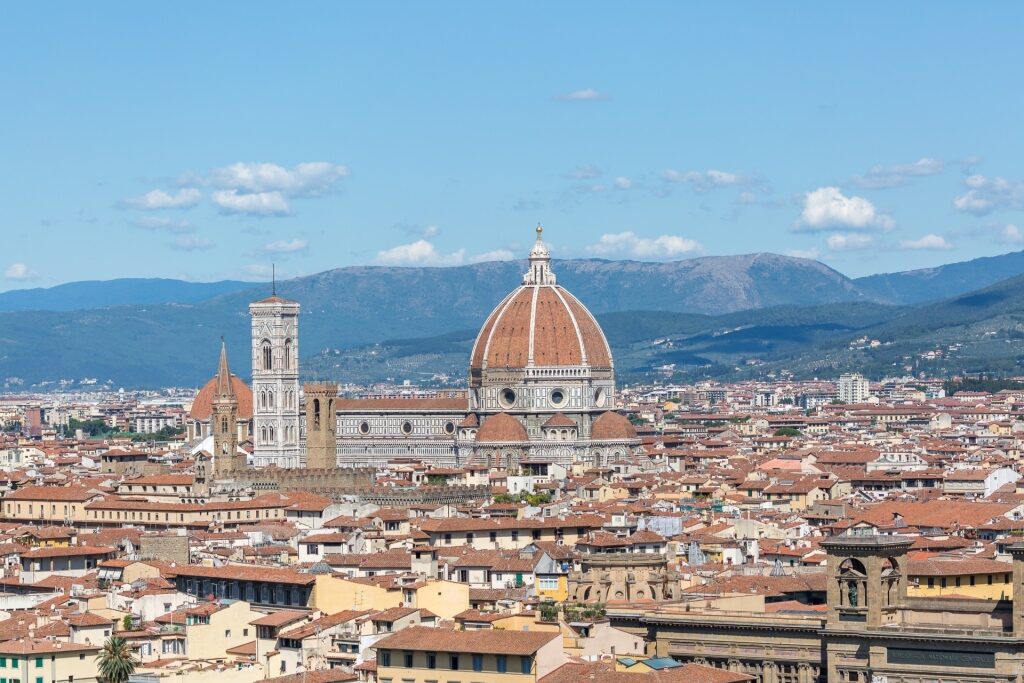
Santa Maria del Fiore in Florence, Italy
You never forget your first sight of Florence’s magnificent cathedral, among the most famous landmarks in Europe. Its soaring dome remains an engineering marvel, designed by Filippo Brunelleschi in 1420.
The whole is the showpiece of Italian Renaissance architecture, dazzling in white, green, and pink marble. Started in 1296, its builders overcame many challenges such as putting in place that 37,000-ton dome without scaffolding.
Visit the cathedral museum to see original sculptures and some of the tools used during construction. They give a powerful insight into the genius of those Renaissance engineers.
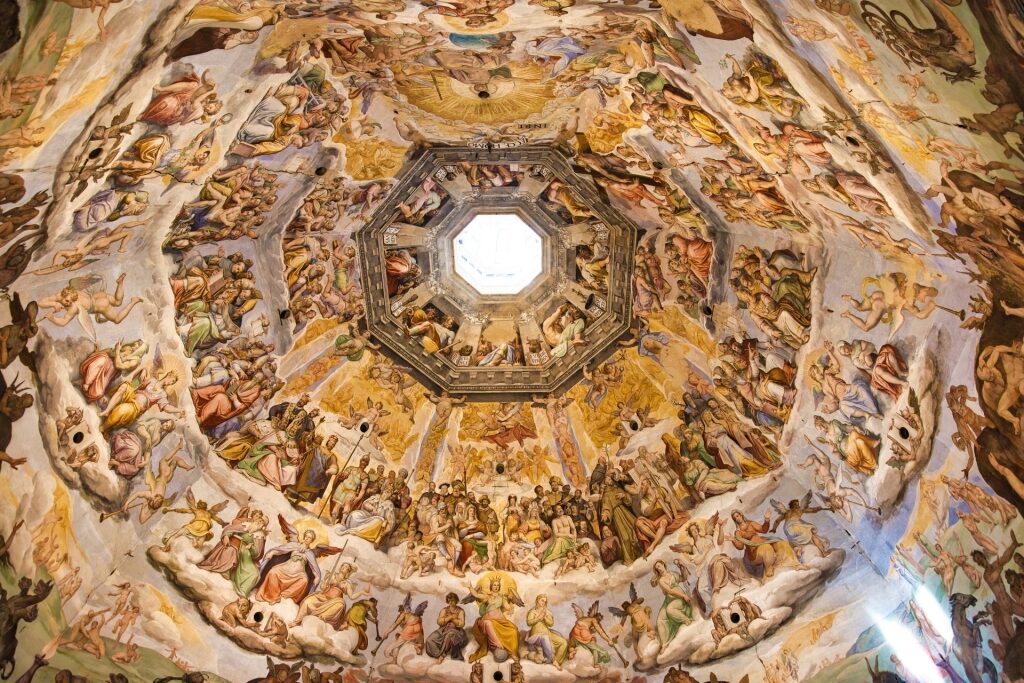
Last Judgment inside Santa Maria del Fiore in Florence, Italy
For more art in Florence, visit Giorgio Vasari’s monumental Last Judgment fresco inside the dome. Ghiberti’s famous Gates of Paradise bronze doors to the Baptistery and Giotto’s elegant campanile are other must-sees.
Climb the 463 steps of the dome to soak in the view over the rooftops of Florence. You can also enjoy a closer look at those Vasari frescoes, inspired by Michelangelo’s work on the Sistine Chapel.
Grand Canal, Venice, Italy
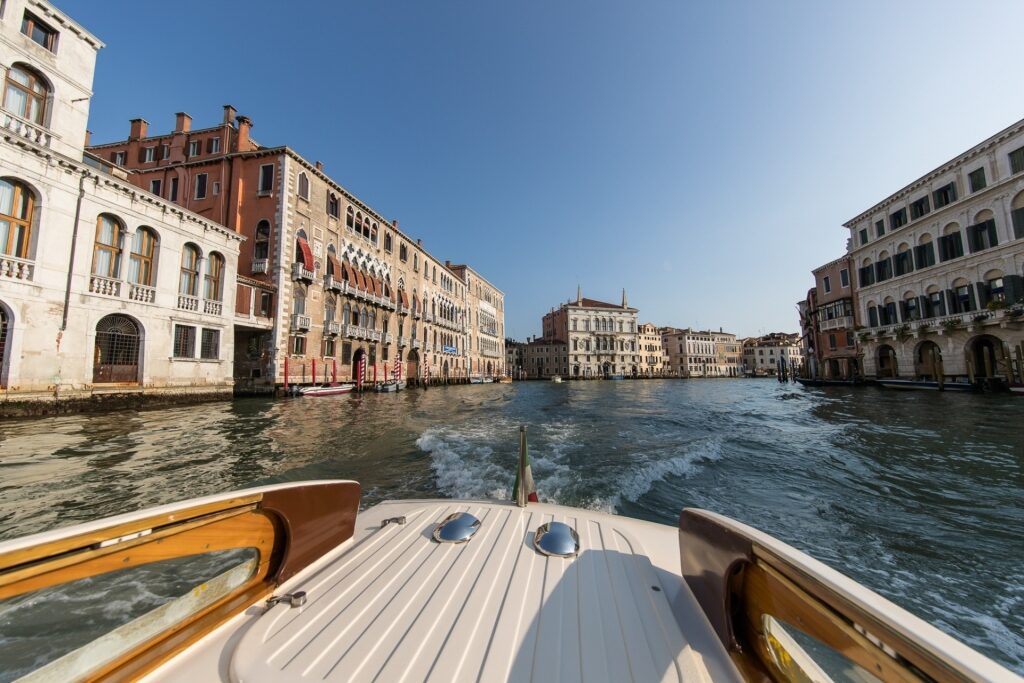
Grand Canal in Venice, Italy
A European landmark that’s famous worldwide, Venice’s Grand Canal follows the wide sweeping S-bend of a former river. That’s the first thing to make it stand out from the city’s narrower, man-made canals.
The second is that its grand buildings face the water, unlike much of the rest of Venice. Elsewhere, the houses turn their backs to the canals, as places once suited only for waste and utilitarian use.
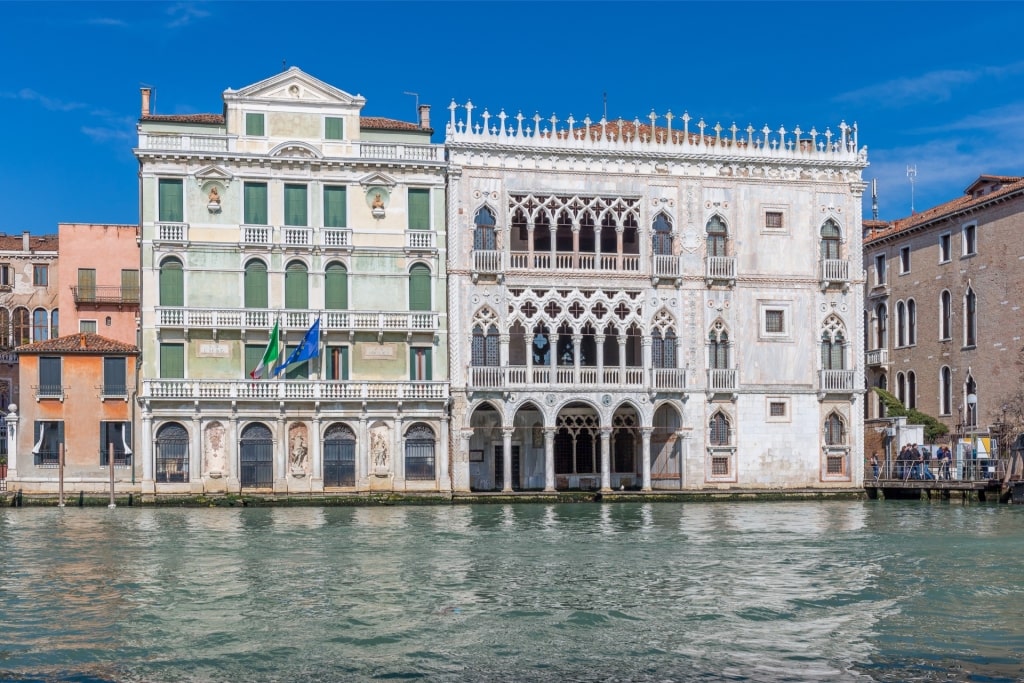
Ca’ d’Oro in Venice, Italy
The Grand Canal is lined with more than 170 palaces showing the evolution in Venetian architectural style from Byzantine through Renaissance to Baroque. It’s a magnificent open-air museum as well as a main “street” and busy transport hub.
Highlights include Gothic palaces such as Ca’ d’Oro with its Islamic-inspired motifs and Renaissance masterpieces such as Palazzo Grimani. Four bridges span the canal, most famously the high-curving Rialto Bridge of 1591, and the modern Ponte dell’Accademia.
Old Town Dubrovnik, Croatia
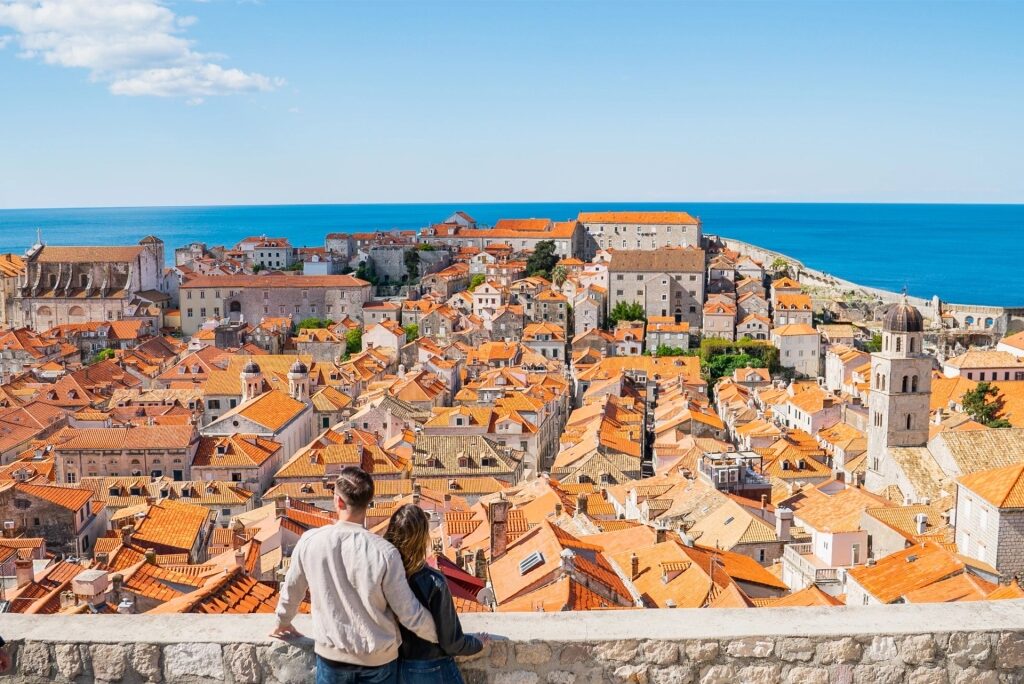
Old Town Dubrovnik, Croatia
Dubrovnik’s medieval old town shelters within one of the world’s most impressive city walls. Walk them to take in the view of the terracotta-tiled roofs and bright blue Adriatic Sea.
Then find your way to the wide central avenue of Stradun. This elegant pedestrian street was created in 1468 by filling in a water channel to unite two settlements.
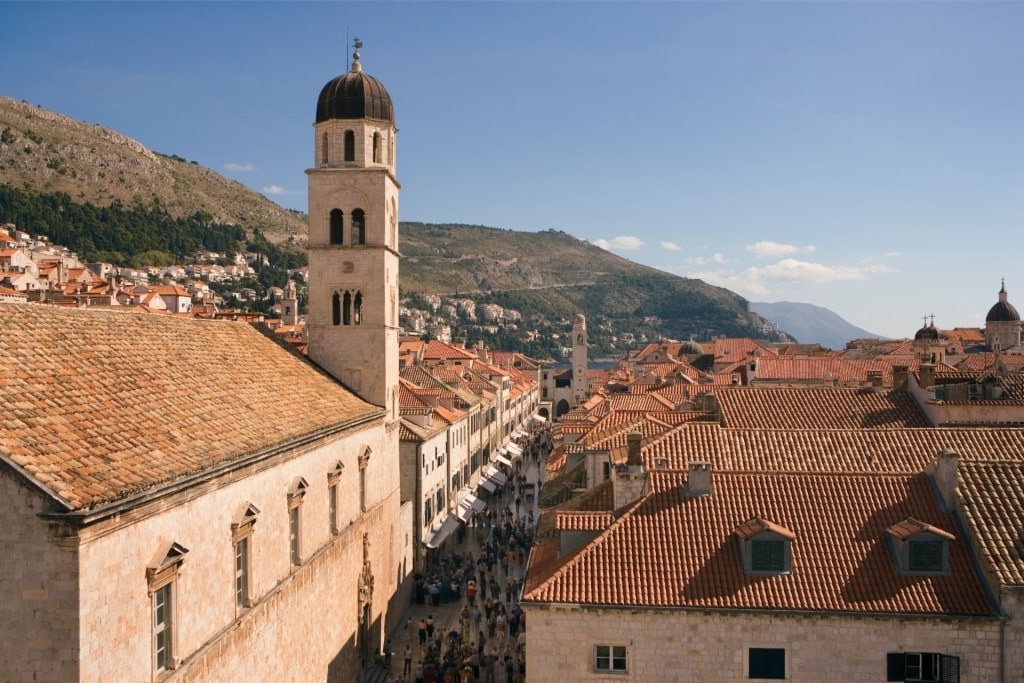
Stradun in Old Town Dubrovnik, Croatia
In its marble, you can still see damage from shelling dating to the Croatian War of Independence of 1991-92. The city withstood a three-month siege with no running water or electricity during which seven Baroque palaces were burned.
A 14th-century pharmacy, one of Europe’s three oldest, still operates today. The same is true of the medieval wastewater system, hidden away beneath the limestone streets.
Mdina, Malta
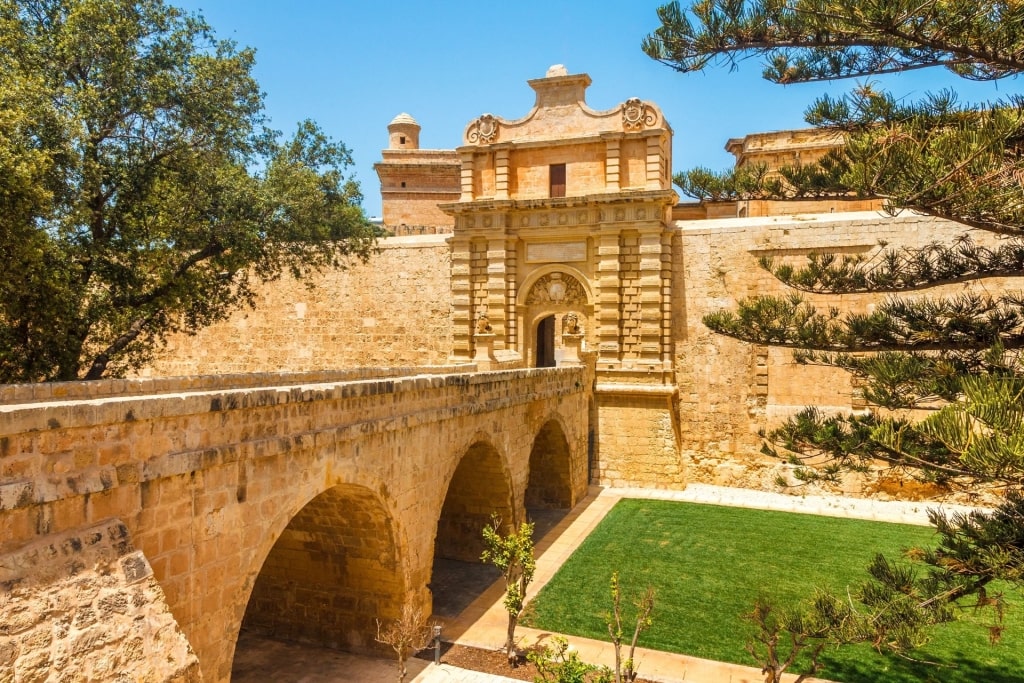
Mdina, Malta
Malta’s ancient capital is a layer cake of history, continuously inhabited since the Bronze Age. Founded around 700 BCE, Mdina is one of Europe’s oldest living cities.
Its street layout has Phoenician roots from the eighth century BCE, while its enclosing Norman fortifications are almost 1,000 years old. A 1693 earthquake saw extensive Baroque reconstruction, although many medieval elements were preserved.

St. Paul’s Cathedral in Mdina, Malta
The cathedral, rebuilt between 1697 and 1702, has impressive Mattia Preti frescoes. The Cathedral Museum is a Baroque treasure full of precious art, including Durer woodcuts, Rembrandt engravings, rich vestments, and a priceless coin collection.
Don’t miss the Palazzo Falson museum, a historic house dating to the 13th century that’s stuffed with thousands of precious artifacts. Besides furniture, paintings, and armor, it includes even rarer objects such as a timepiece by Robert Robin.
Ephesus, Turkey
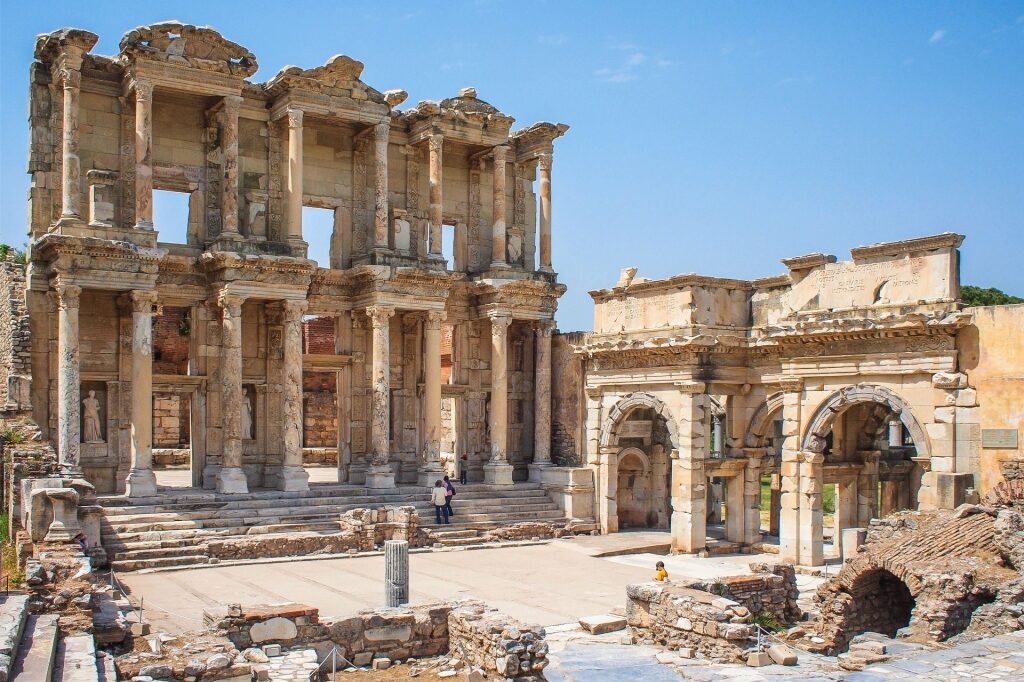
Library of Celsus in Ephesus, Turkey
Ephesus is a remarkably preserved Greco-Roman city that was the site of the Temple of Artemis, one of the Seven Wonders of the Ancient World. Its remnants are overshadowed by other amazing buildings, such as the Great Theatre of 117 AD, with space for 25,000 spectators.
Just as impressive is the Library of Celsus, built in 125 AD, that held 12,000 scrolls. Curetes Street shows off skills of another type, with thick marble slabs laid over sophisticated drainage channels.

Terrace Houses in Ephesus, Turkey
The Terrace Houses show how wealthy Romans lived, enjoying frescoed walls and an underfloor heating system. Recent excavations have uncovered a gladiator cemetery and communal toilets with marble seats.
Those toilets made use of a remarkable city water system, founded on miles of aqueducts. Pressurized clay pipes supplied thousands of residents with fresh water every day.
Bryggen, Bergen, Norway
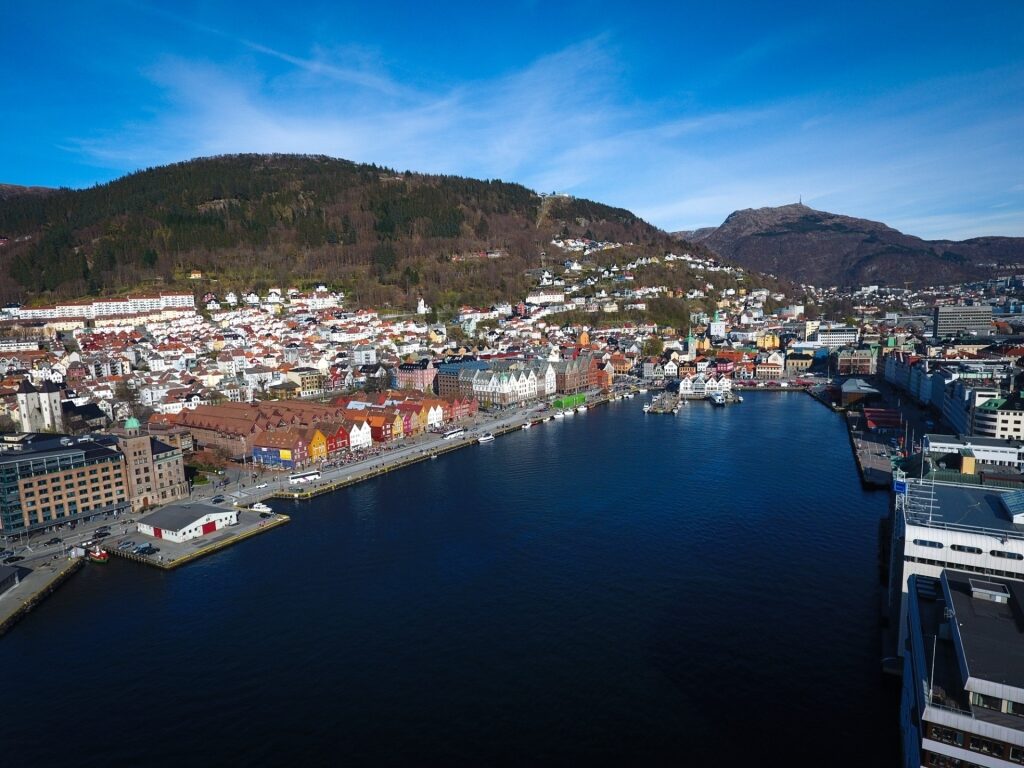
Bryggen in Bergen, Norway
The colorful buildings of Bryggen, Bergen’s historic wharf, whisk you back to the days of the Hanseatic League. The 62 wooden structures represent one of Europe’s best-preserved medieval trading posts.
Between 1350 and 1750, the Bergen port exported some 60 million pieces of stockfish to markets around Europe. This dried cod was Norway’s major trade product from the Viking Age to the end of the medieval period.
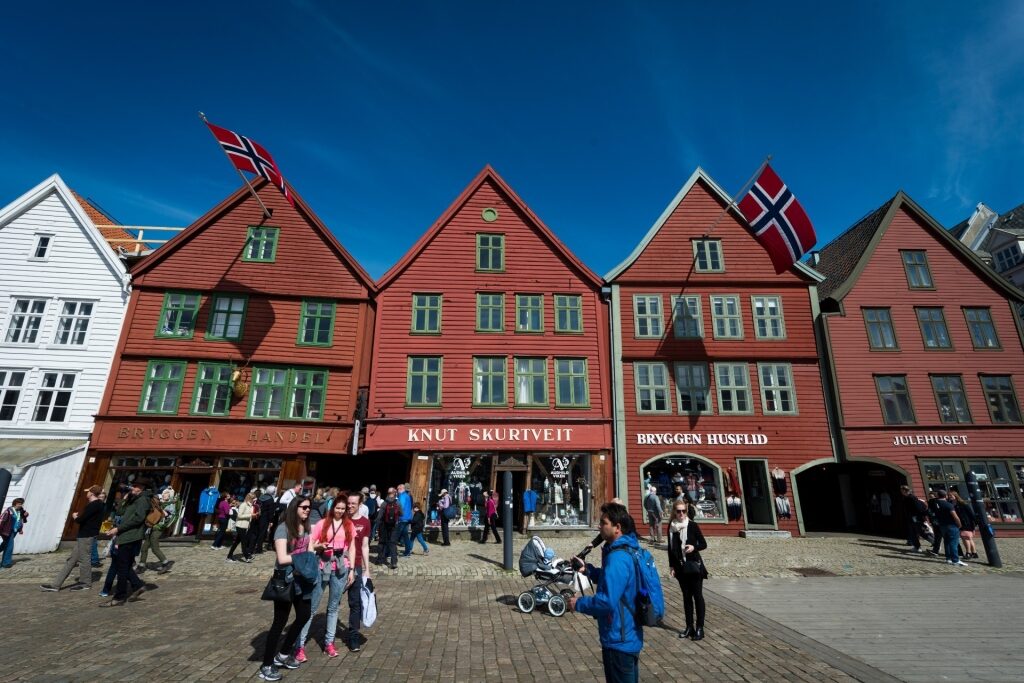
Bryggen in Bergen, Norway
The town was rebuilt using traditional Nordic building techniques after a major fire in 1702. It follows the original medieval plot divisions, with shared courtyards connected by very narrow passages.
You’ll note many houses have external staircases and protruding beams to hoist cargoes. Tour the Hanseatic Museum to learn more, and see original merchant records documenting North Sea trade from 1366 to 1862.
The Little Mermaid Statue, Copenhagen, Denmark

The Little Mermaid Statue in Copenhagen, Denmark
One of the famous landmarks in Europe surprises many first-time viewers by being so, well, little. Sitting just over four feet high, the Little Mermaid really does have an oversized reputation compared to the reality.
Nevertheless, paying your respects is one of the best things to do in Copenhagen. You’ll easily find her along the Langelinie waterfront by looking for the crowds of selfie-takers.
The bronze statue by artist Edvard Eriksen, unveiled in 1913, was based on his wife’s body and the face of ballerina Ellen Price. She had danced the role of The Little Mermaid in Copenhagen’s Royal Ballet.
Both statue and ballet were inspired by an 1837 story by Hans Christian Andersen, as was the famous Disney film. The statue was commissioned by Carl Jacobsen, the founder of Carlsberg beer and a fan of Ellen Price.
Pont du Gard, France
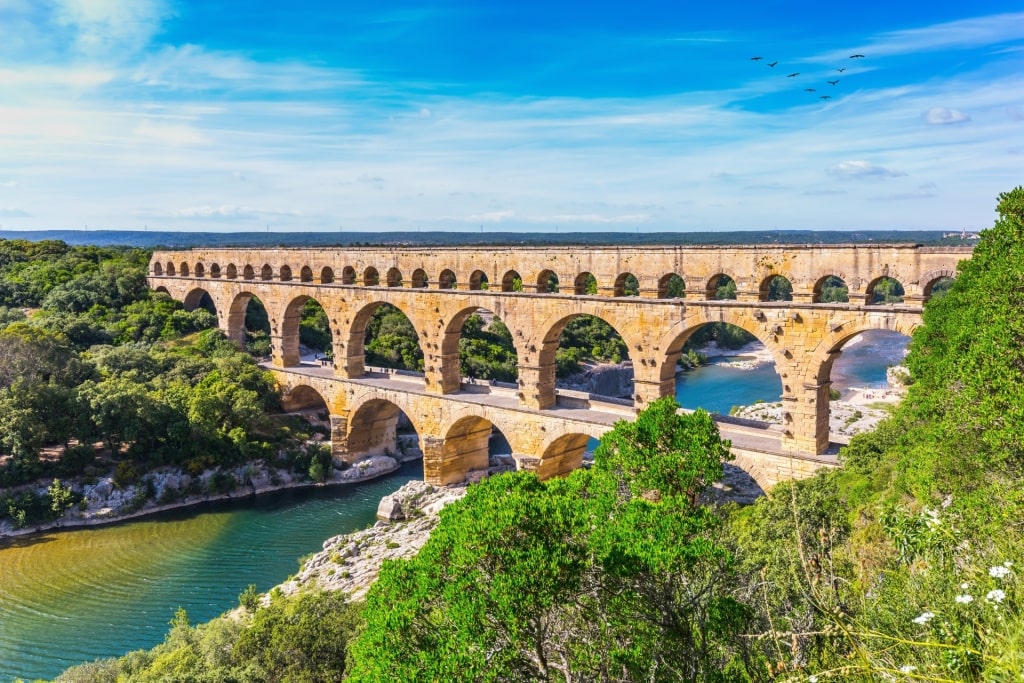
Pont du Gard, France
This Roman aqueduct bridge, built between 40 and 60 AD, still impresses today with its scale, ambition, and beauty. Rising some 150 feet in three elegant tiers, it spans nearly 1,000 feet across the Gardon River in southern France.
Pont du Gard’s aqueduct carried 11,000,000 US gallons of water a day to Nîmes over a distance of 30 miles at a 1 in 3,000 gradient. Recognized as one of antiquity’s greatest engineering feats, the bridge was in use until the sixth century.
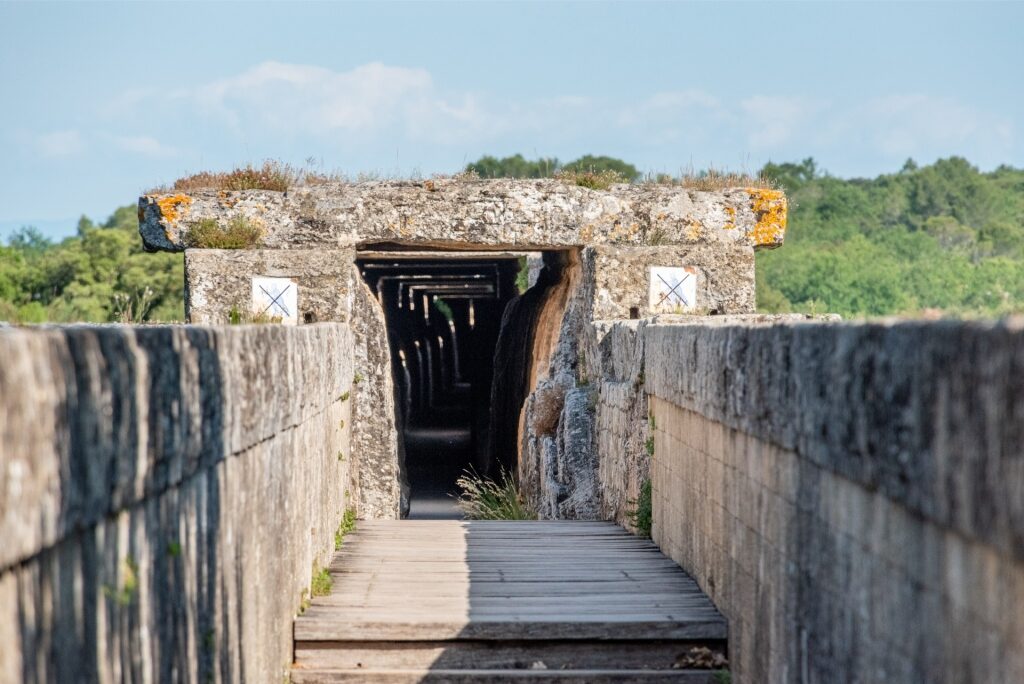
Pont du Gard, France
Its builders used 50,400 tons of limestone blocks, fitted together without mortar to precise tolerances. There were originally 52 arches, of which 35 survive today.
You can walk across the bridge to see the stone-working for yourself and even go inside the aqueduct. In the museum, you can see exactly how the Pont du Gard was built, along with the background to its construction.
Hallgrímskirkja, Reykjavik, Iceland
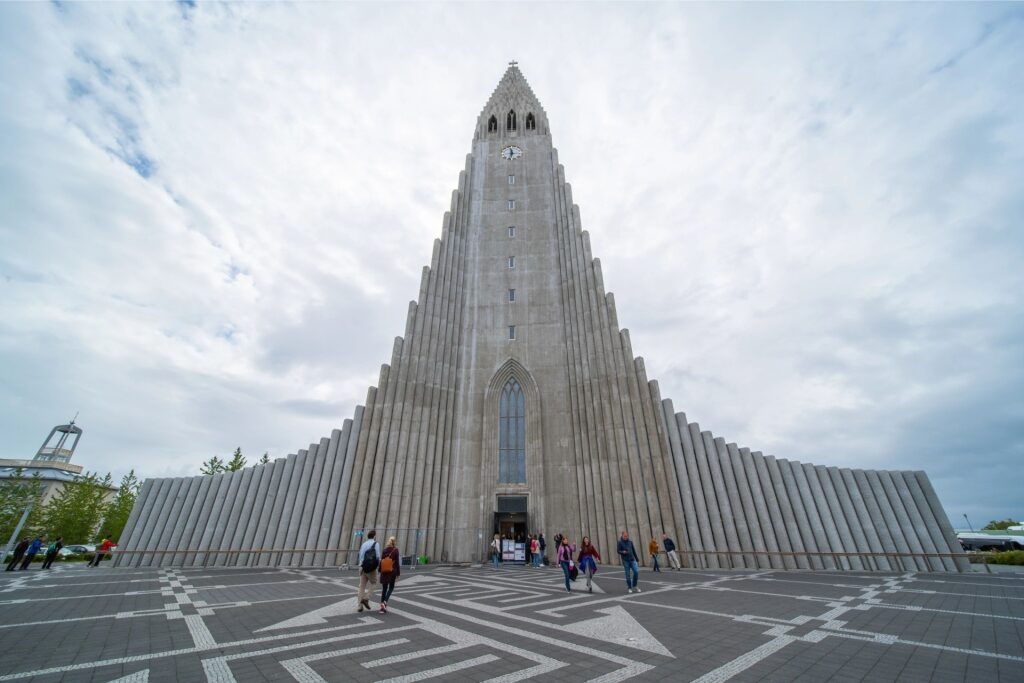
Hallgrímskirkja in Reykjavik, Iceland
This highly unusual church took 41 years to complete, following a design based on the widespread basalt lava columns of Iceland. Finished in 1986, it was built from reinforced concrete to withstand the country’s frequent seismic activity.
The soaring interior has acoustics that give a natural, three-second reverberation, matching Icelandic hymnal traditions. It’s dominated by an elegant modern organ, with 5,275 pipes.
Hallgrímskirkja is named for Icelandic poet and clergyman Hallgrímur Pétursson, known for his Passion Hymns. He had an interesting life, once working as a blacksmith, and dying of leprosy in 1674.
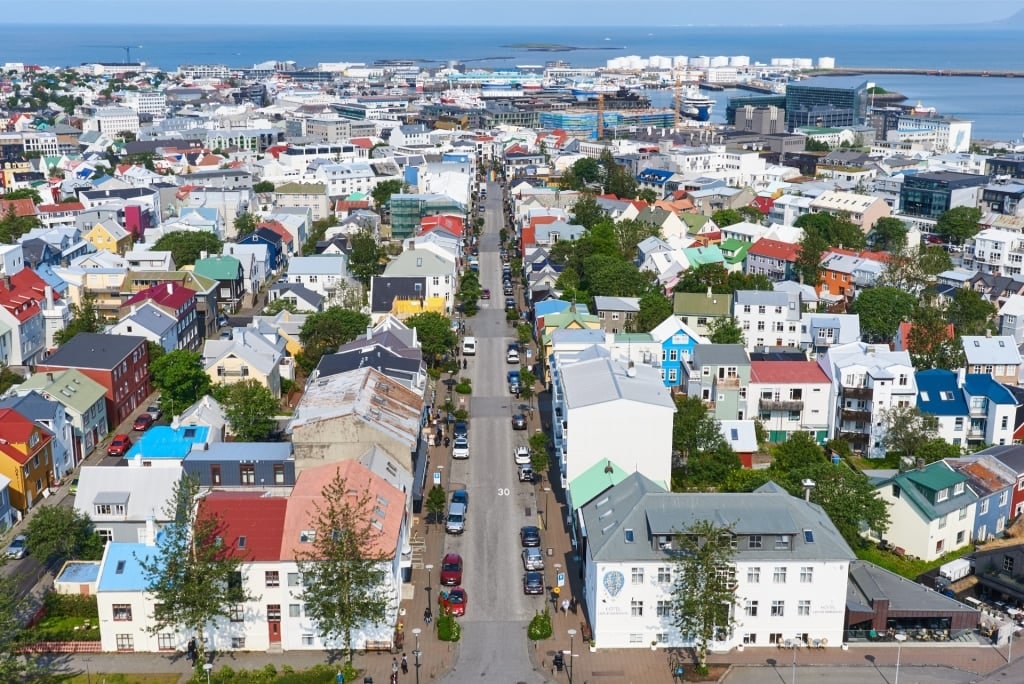
Hallgrímskirkja in Reykjavik, Iceland
Take the elevator up the 250-foot-high tower for panoramic views of Reykjavik. The statue outside, predating the church and showing Viking explorer Leifur Eiríksson, was a gift from the US in 1930.
Giant’s Causeway, Northern Ireland
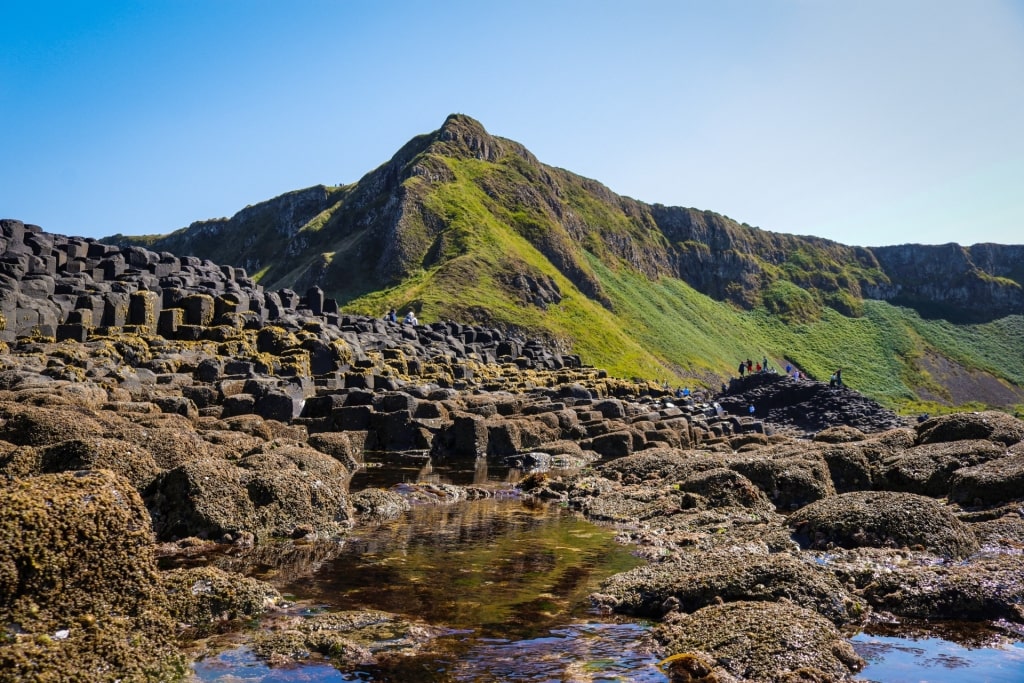
Giant’s Causeway, Northern Ireland
One of the grandest of Europe’s landmarks was built as a causeway to Scotland by Irish giant Fionn mac Cumhaill. He wanted to battle a rival giant on the Scottish side, Benandonner.
Of course, in the visitor center, you’ll hear the scientific version that the causeway was formed during volcanic activity 60 million years ago. Its 40,000 interlocking basalt columns are the result of a flow of hot lava rapidly cooling in the sea.
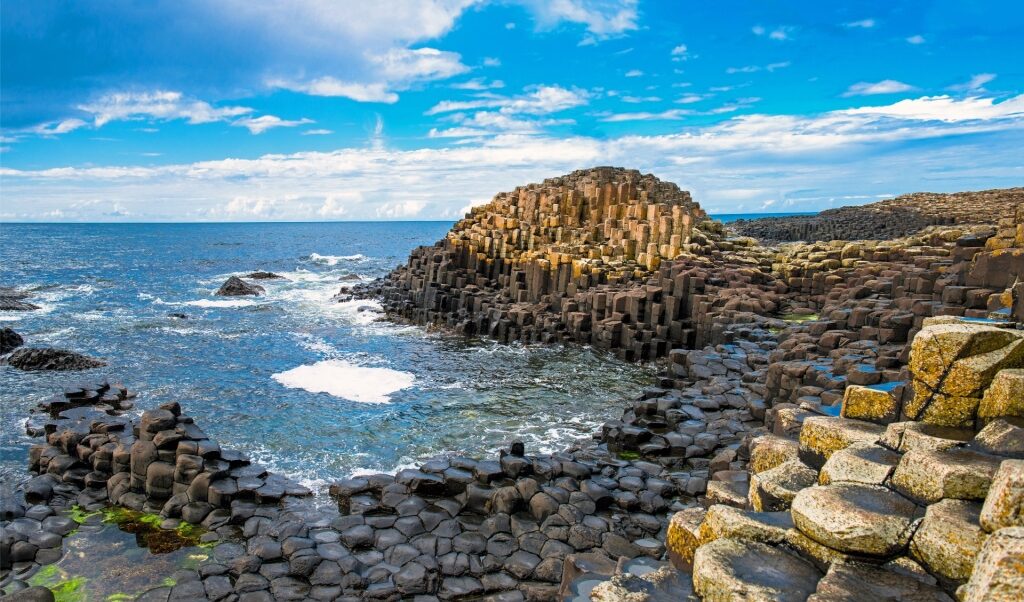
Giant’s Causeway, Northern Ireland
Walk around and you’ll see formations dubbed “The Giant’s Boot” and the “Organ” with its towering pipes. You’ll be joining the more than one million visitors who come every year to admire this awesome natural wonder.
In 2020, 3D mapping confirmed that the basalt formations do extend underwater, connecting to similar geological structures in Scotland. Score a point for the Fionn mac Cumhaill team.
FAQs
What are the three most famous landmarks in Europe?
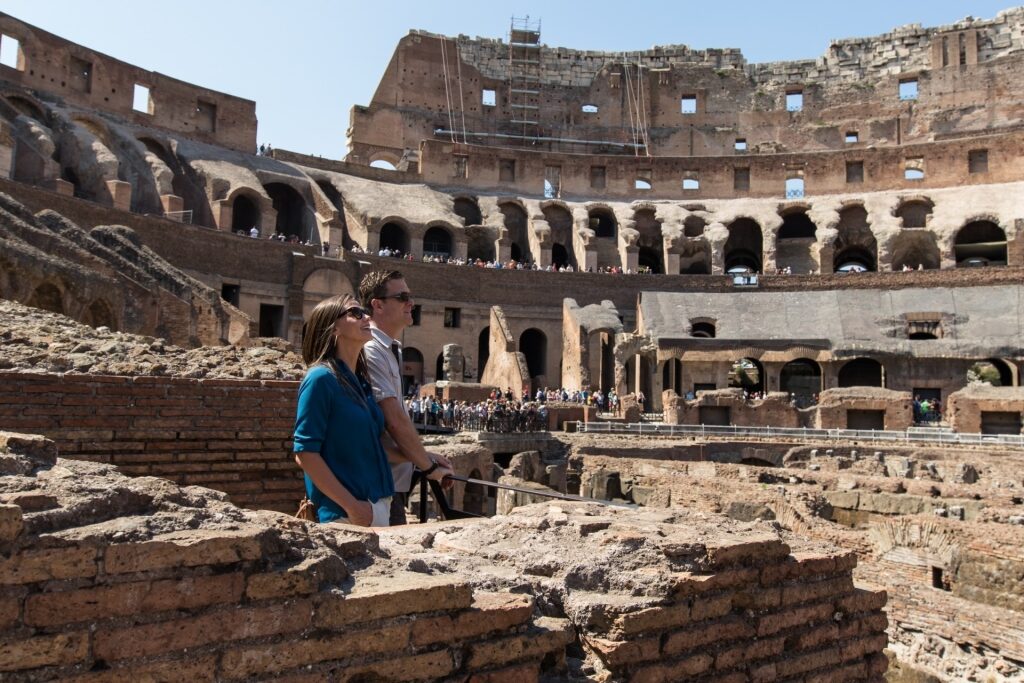
Colosseum in Rome, Italy
This is a matter of personal preference but the most famous landmarks in Europe are arguably the Eiffel Tower in Paris, Rome’s Colosseum, and London’s Big Ben.
Which of Europe’s landmarks are UNESCO World Heritage Sites?
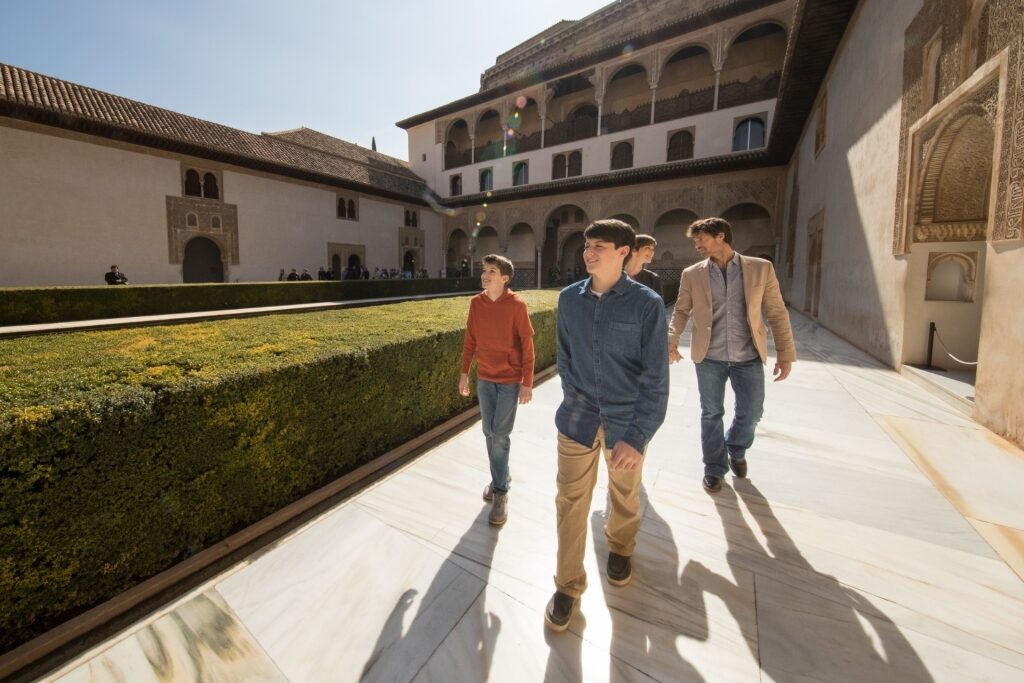
Alhambra Palace in Granada, Spain
Most of the major European landmarks have been recognized by UNESCO, including the Colosseum, Parthenon, Stonehenge, the Alhambra, Hagia Sophia, Versailles, Mont-Saint-Michel, and the Pont du Gard.
What are the oldest landmarks in Europe?
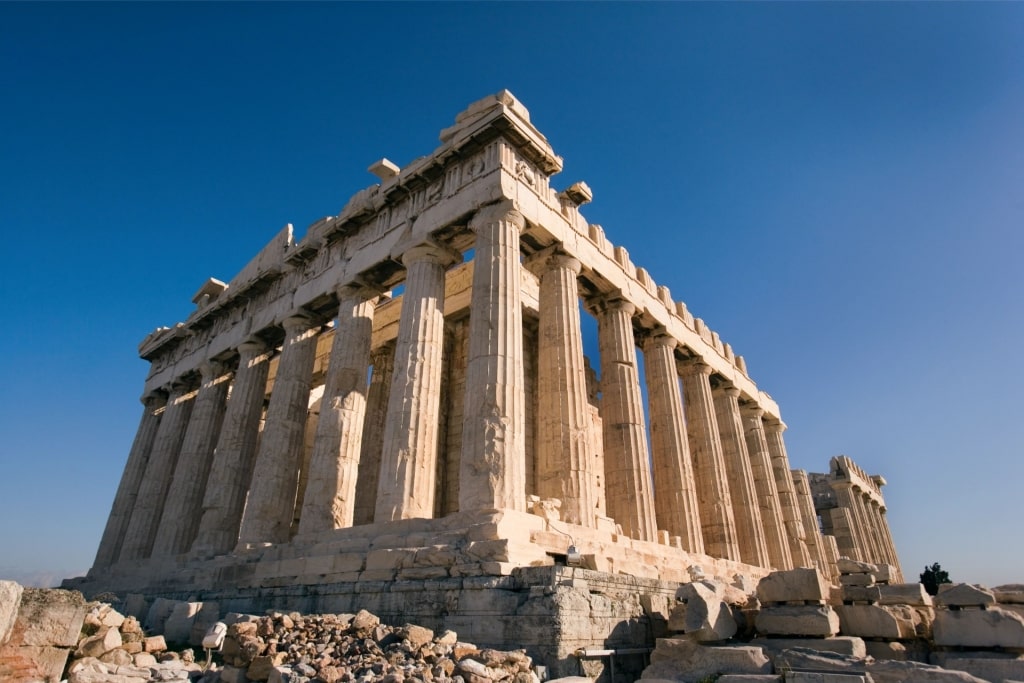
Parthenon in Athens, Greece
The oldest landmark is Stonehenge, from 3100 BCE, with the Parthenon dating to 447 BCE, the Colosseum to 80 AD, and the Pantheon to 126 AD.
What are the best landmarks in Europe for photography?

Eiffel Tower in Paris, France
This is always subjective but favorites would be the Eiffel Tower, Santorini, Venice, and the Sagrada Família in Barcelona.
Do I need tickets in advance for popular European landmarks?
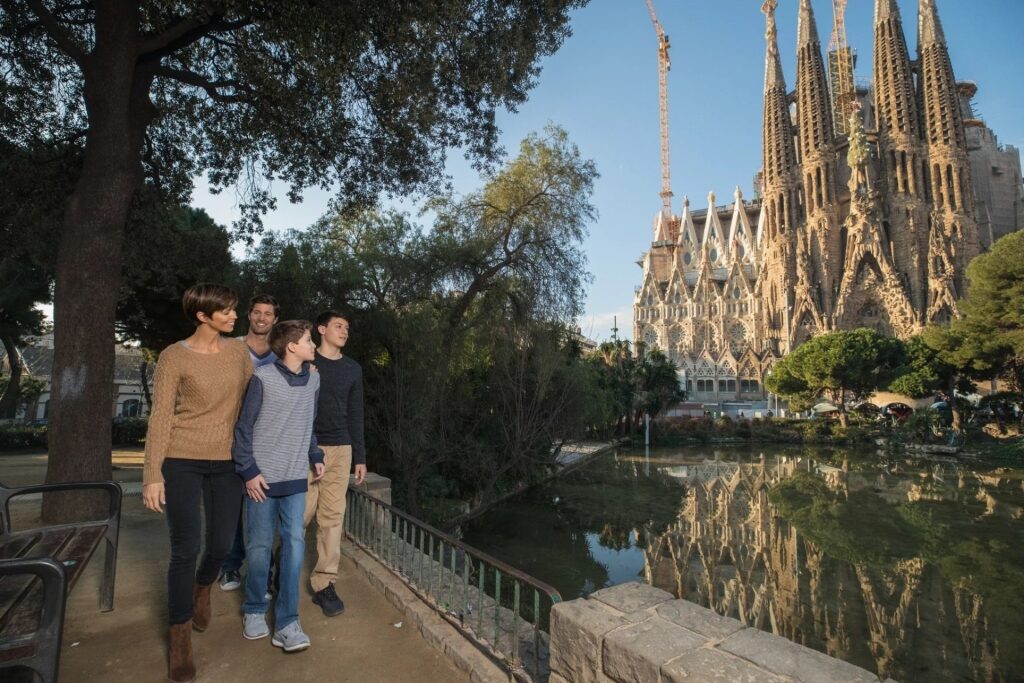
Sagrada Família in Barcelona, Spain
Yes, most of the popular ones, including the Eiffel Tower, Colosseum, Sagrada Família, and Versailles will need to be booked weeks ahead in summer.
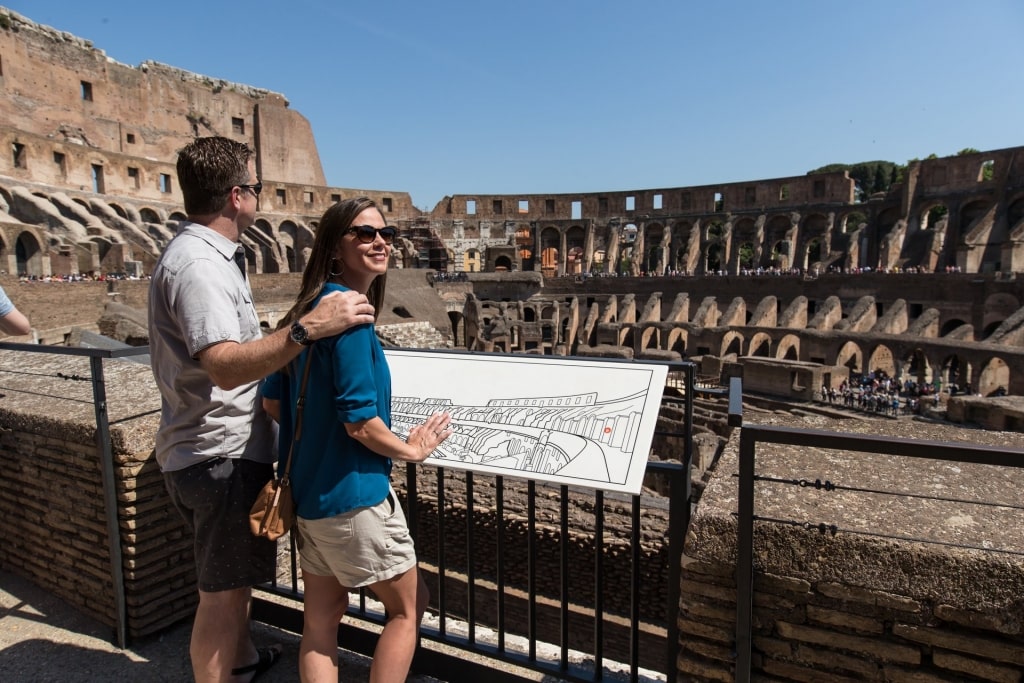
Colosseum in Rome, Italy
What do all of these famous landmarks in Europe have in common? You can visit all of them while sailing around Europe on a dream cruise vacation. Browse our cruise itineraries and be on your way to a bucket-list European vacation.
